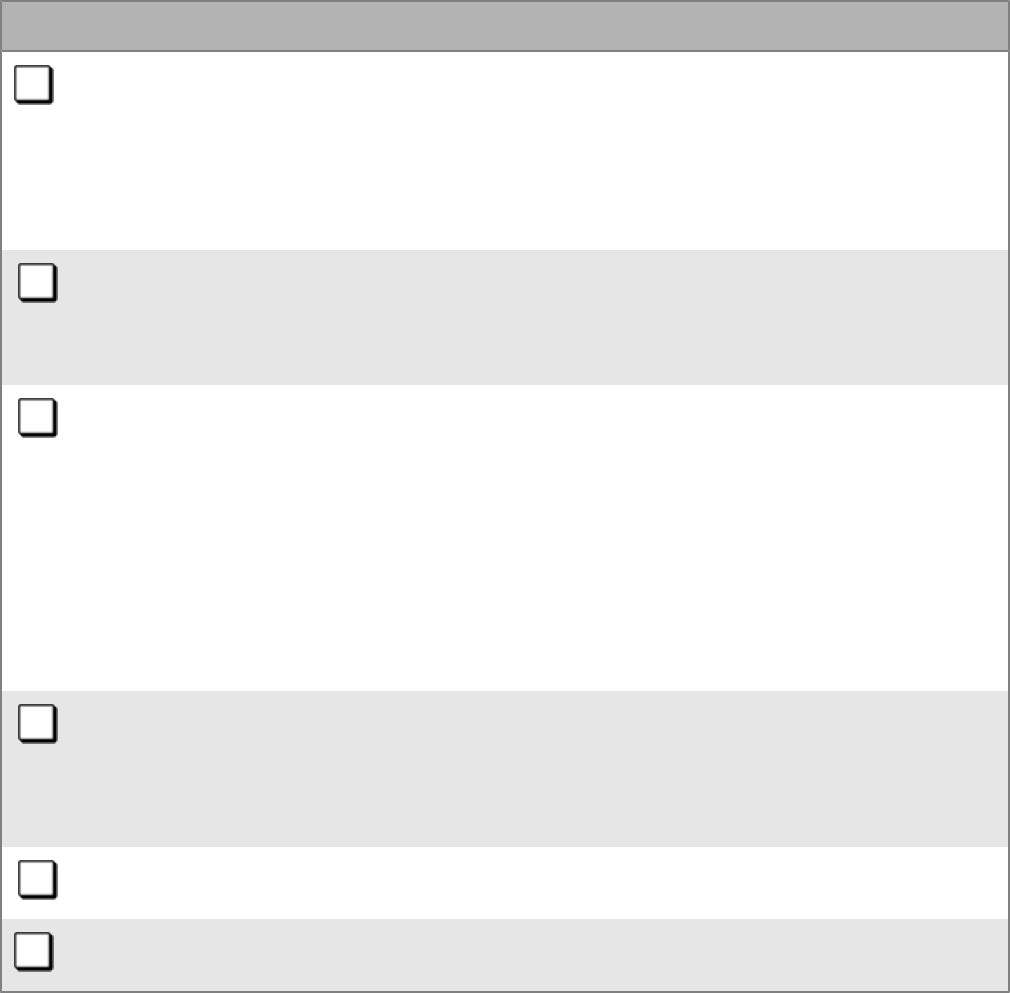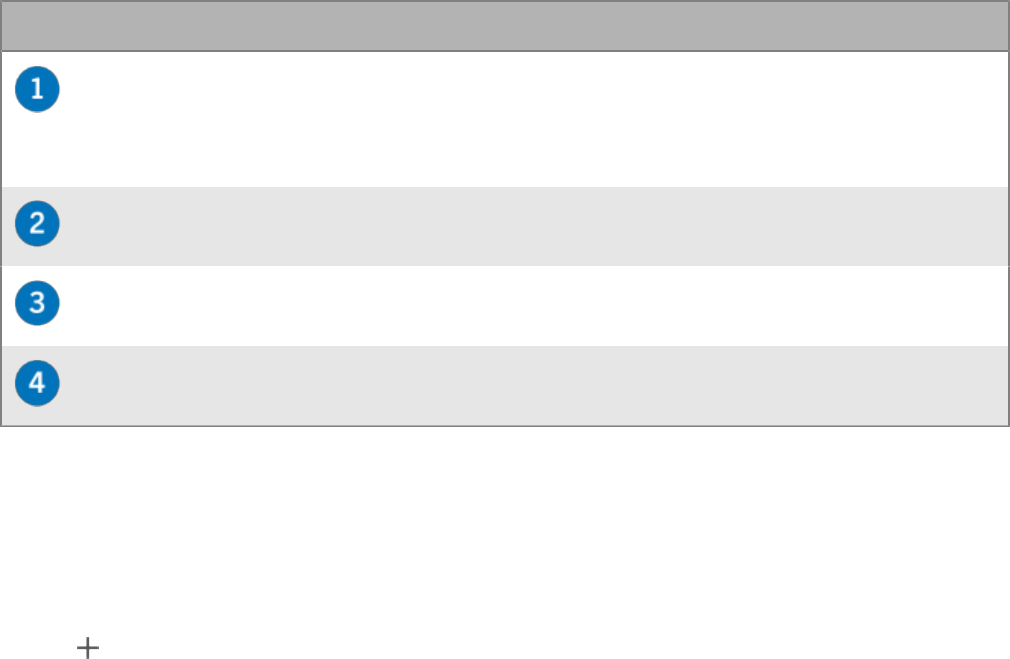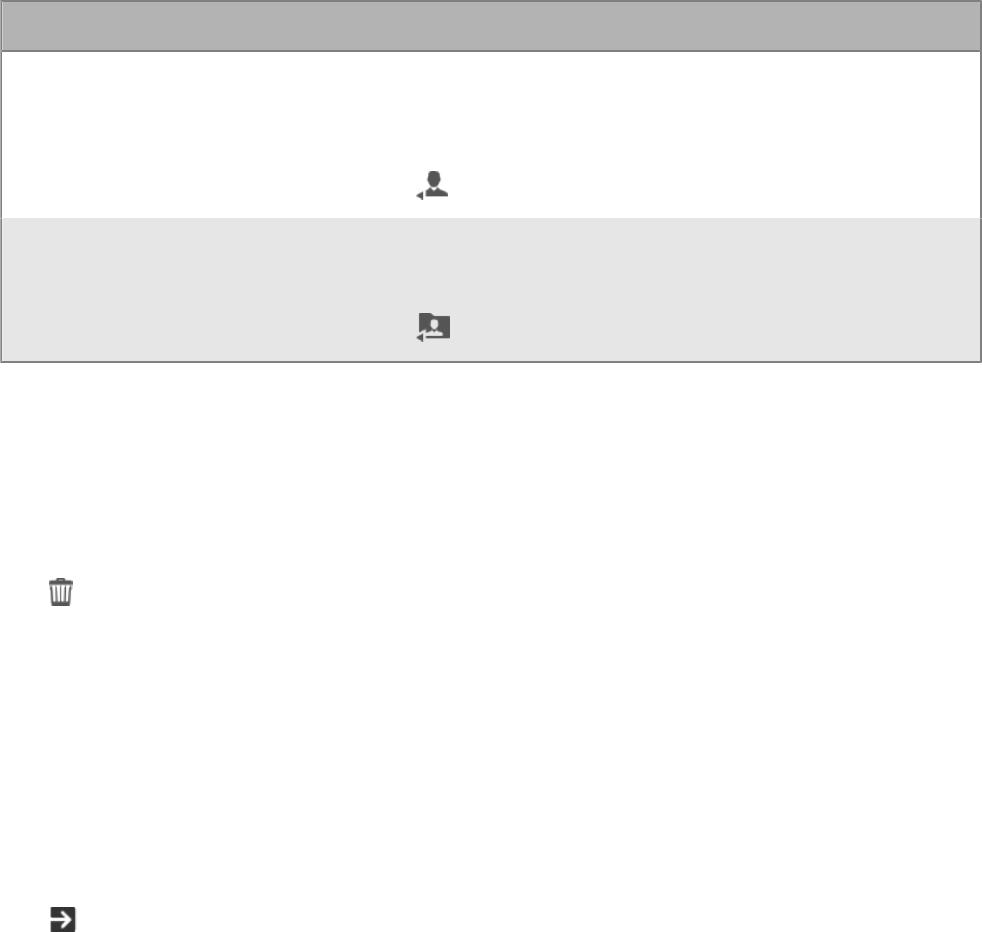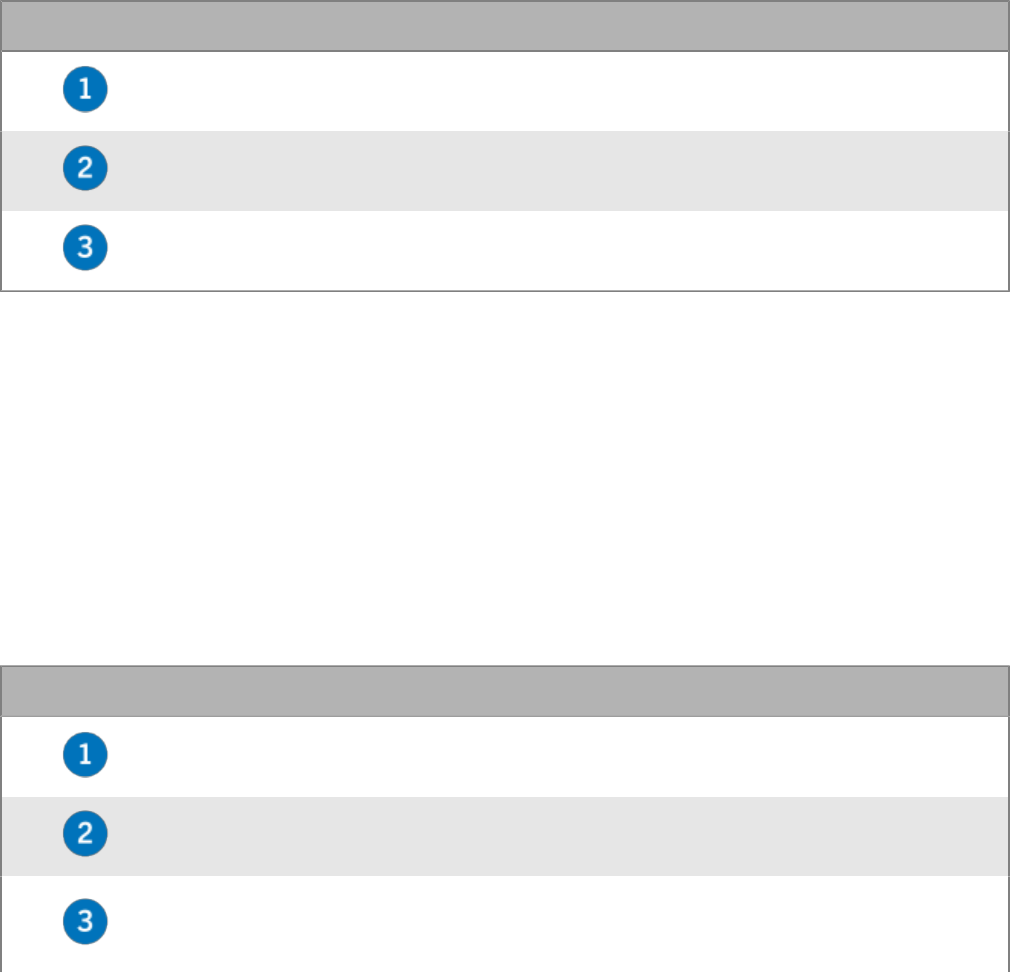
BlackBerry UEM
Administration
Windows 10 Planning and Deployment
2020-06-04Z
||2
Contents
Introduction toWindows 10deployment withBlackBerry UEM.......................... 5
Key features forWindows 10devices inUEM.....................................................................................................5
Checklist for managing devices withUEMonly................................................. 8
Checklist for managing devices withUEMand SCCM....................................... 9
EnrollingWindows 10devices withBlackBerry UEM....................................... 10
Enrolling a device to be managed withBlackBerry UEM.................................................................................. 10
Create an activation profile forWindows 10devices............................................................................10
SimplifyingWindows 10activations....................................................................................................... 11
Activate aWindows 10device................................................................................................................ 14
Install a certificate to activate aWindows 10device withWindows Autopilot....................................15
Enrolling an unmanaged device withBlackBerry Access for Windows........................................................... 16
Setting upUEMpolicies and profiles to manageWindows 10devices............. 17
Import SCCM group policies toUEM................................................................................................................. 17
Restricting or allowing device capabilities.........................................................................................................17
Setting device password requirements.............................................................................................................. 18
HowBlackBerry UEMchooses which IT policy to assign................................................................................ 18
Creating and managing IT policies.....................................................................................................................18
Create an IT policy....................................................................................................................................18
Copy an IT policy...................................................................................................................................... 18
Rank IT policies.........................................................................................................................................19
View an IT policy...................................................................................................................................... 19
Change an IT policy..................................................................................................................................19
Remove an IT policy from user accounts or user groups..................................................................... 19
Delete an IT policy....................................................................................................................................20
Export IT policies...................................................................................................................................... 20
Sending certificates to devices using profiles...................................................................................................20
Choosing profiles to send client certificates to devices....................................................................... 21
Sending CA certificates to devices......................................................................................................... 21
Using SCEP to send client certificates to devices.................................................................................22
Setting up work email for devices......................................................................................................................23
Create an email profile.............................................................................................................................23
Create an IMAP/POP3 email profile....................................................................................................... 24
Using Exchange Gatekeeping..............................................................................................................................24
Allow a device to access Microsoft ActiveSync.................................................................................... 24
Block a device from accessing Microsoft ActiveSync...........................................................................25
Verifying that a device is allowed to access work email and organizer data.......................................25
Creating a gatekeeping profile.................................................................................................................25
Setting up work VPNs for devices......................................................................................................................26
||iii
Create a VPN profile.................................................................................................................................26
Enabling per-app VPN...............................................................................................................................27
Setting up work Wi-Fi networks for devices...................................................................................................... 27
Create aWi-Fiprofile................................................................................................................................27
Enforcing compliance rules for devices.............................................................................................................28
Create a compliance profile.....................................................................................................................28
Windows: Compliance profile settings....................................................................................................28
Setting up Windows Information Protection for Windows 10 devices............................................................ 31
Create aWindowsInformation Protection profile..................................................................................31
Windows 10: Windows Information Protection profile settings............................................................32
ManagingWindows 10devices that are enrolled inUEMand SCCM..............................................................36
Configuring policies in SCCM.................................................................................................................. 36
Configuring UEM to manage apps forWindows 10devices............................. 38
ConnectingBlackBerry UEMtoMicrosoft Azure...............................................................................................38
Create a Microsoft Azure account.......................................................................................................... 39
SynchronizeMicrosoft Active DirectorywithMicrosoft Azure..............................................................39
Create an enterprise endpoint inAzure.................................................................................................. 39
Configuring BlackBerry UEM to synchronize with the Windows Store for Business............................40
Specify the shared network location for storing internal apps........................................................................ 42
Add aWindows 10app to the app list.............................................................................................................. 43
Allowing users to install onlineWindows 10apps................................................................................ 43
Add an app category for a Windows 10 app..........................................................................................43
App behavior on Windows 10 devices............................................................................................................... 44
Setting up network connections forBlackBerry Dynamicsapps..................................................................... 45
Create aBlackBerry Dynamicsconnectivity profile............................................................................... 45
Add an app server to aBlackBerry Dynamicsconnectivity profile....................................................... 45
BlackBerry Dynamicsconnectivity profile settings................................................................................ 46
Remote management for Windows 10 devices................................................48
Sending commands to users and devices.........................................................................................................48
Send a command to a device..................................................................................................................48
Send a bulk command............................................................................................................................. 48
Set an expiry time for commands...........................................................................................................50
Commands reference............................................................................................................................... 50
Locate a device.................................................................................................................................................... 51
ManagingWindows 10device updates withBlackBerry UEM.......................... 52
UsingBlackBerry Intelligent Security.............................................................. 53
Deactivating devices....................................................................................... 54
Related information.........................................................................................55
Legal notice.................................................................................................... 56
||iv

Introduction toWindows 10deployment withBlackBerry
UEM
Organizations across various industries are includingWindows 10tablets and laptops in their mobility strategy
planning. Currently, they might use traditional methods such asMicrosoftSystem Center Configuration Manager
(SCCM) or other client management tools to manageWindows 10devices,whileiOSandAndroidsmartphones
and tablets are managed with another MDM solution. To manageWindows 10,iOS, andAndroiddevices in a
unified management console, you can useBlackBerry UEM.
To supportWindows 10devices,BlackBerry UEMprovides multiple deployment options and scenarios:
• SpecializedWindows 10devices fully managed by BlackBerry UEM:Administrators can manageWindows
10devices from theUEMmanagement console after users activate their devices withUEM. Administrators
can view and manage activated devices through a unified interface. Users can also use theBlackBerry
UEM Self-Serviceconsole to perform simple administrative actions (for example, wipe work data,
locate a lost device, activate new devices, or generate access keys for BlackBerry Dynamics apps).
When devices are activated withUEM, you can also easily deploy apps from the app store or enterprise
apps (for example,BlackBerry Access,BBM Enterprise, andBlackBerry Workspaces) to users from
theUEMmanagement console.
• CorporateWindows 10devices managed byBlackBerry UEMandMicrosoftSCCM (in
coexistence):Administrators can use eitherBlackBerry UEMandMicrosoftSCCM solutionsexclusivelyto
manageWindows 10devices in their organization or they can adopt theWindows 10management features
ofBlackBerry UEMtogether with the group policies of SCCM.UEMand SCCM can co-exist: devices can
beenrolled and managed by both solutionssimultaneously.
• Unmanaged devices (for personal devices, contractors, or external parties):If you don't want to
manageWindows 10devices but still want users to access your organization's intranet and work email,
users can installBlackBerry Access for Windowsand activate it using aBlackBerry Dynamicsaccess key.
Administrators can generate access keys for users from theUEMmanagement console, and if allowed,
users can generate them from theBlackBerry UEM Self-Serviceconsole. Any device can activateBlackBerry
Dynamicsapps, even if it is not managed. For more information,see the BlackBerry Access product
informationandBlackBerry Workspaces product information.
Key features forWindows 10devices inUEM
The following table highlights the features available to unmanaged devices and managed devices inBlackBerry
UEM. You can manageWindows 10devices, includingWindows 10tablets and computers.Silverlicenses are
required to activateWindows 10devices.
Feature Description
Unmanaged devices
(devices that are not
managed byUEM)
You can enable secure access to work content even ifUEMdoes not manage the
device.
To enable secure access to the work intranet, email, and contacts, you
deployBlackBerry AccessforWindows 10devices. For more information
aboutBlackBerry Access,see the BlackBerry Access Administration Guide.
To enable secure file-sharing, you can deployBlackBerry Workspaces. For more
information,see the BlackBerry Workspaces server content.
|Introduction toWindows 10deployment withBlackBerry UEM|5

Feature Description
Managed devices
(devices that are
managed byUEM)
You can deployWindows 10devices to be managed withUEMonly, or in
coexistence withMicrosoftSystem Center Configuration Manager (SCCM).
When you useUEMto manageWindows 10devices, it allows you to:
• Apply IT policies and profiles
• Deploy apps from theWindows Storefor Business to theBlackBerry UEM App
Catalog
• Configure device update management settings
• Set compliance rules (for example,WindowsHealth Attestation)
Device features
• Wireless activation
• Customize terms of use agreement
• Client app not required
• View and export device details (for example, hardware details)
Security features
• Separation of work and personal data
• Encryption of work data at rest
• Protection of devices using remote IT commands (for example, lock the device)
• Control device capabilities using IT policies (for example, disable camera)
• Enforce password requirements
• Enforce encryption of internal storage
Sending certificates to devices
• CA certificate profiles
• SCEP profiles
Managing work connections for devices
• BlackBerry Dynamicsconnectivity profiles
• Exchange ActiveSyncemail profiles
• IMAP/POP3 email profiles
• Wi-FiandVPN profiles (with proxy)
• WindowsInformation Protection profiles
Managing your organization’s standards for devices
• Activation profiles
• App lock mode profiles
1
• BlackBerry Dynamicsprofiles
• Compliance profiles
|Introduction toWindows 10deployment withBlackBerry UEM|6
• Device profiles
• Enterprise Management Agentprofiles
1
Only forWindows 10Education andWindows 10Enterprise devices.
Protecting lost or stolen devices
• Delete all device data
• Delete only work data
Configuring roaming
• Disable data when roaming
Managing apps
• Distribute public apps from storefront (Windows Store)
• Manage work app catalog
• Manage restricted apps
1
• Distribute internal apps
1
The restricted app list is not required forWindows 10devices because only apps that an administrator assigns
can be installed in the work space or on devices.
|Introduction toWindows 10deployment withBlackBerry UEM|7

Checklist for managing devices withUEMonly
The following check list is intended for administrators that want to manageWindows 10devices withBlackBerry
UEMonly.
Step Description
Configure the latest version ofBlackBerry UEM(12.10 or later)
orBlackBerry UEM Cloudaccording to your organization's specifications.
For more information, refer to the following:
• BlackBerry UEM Installation Guide
• BlackBerry UEM Configuration Guide
• BlackBerry UEM Cloud Configuration Guide
Configure IT policies and profiles for Windows devices. Assign the
policies and profiles to the appropriate users and user groups.
You must allowWindowsdevices to be activated in the activation
profile. For more information, seeEnrolling a device to be managed
withBlackBerry UEM.
Configure UEM to manage apps for Windows 10 devices.Assign the
apps to the appropriate users and user groups.
Activate aWindows 10device.
After activation, you can manageWindows 10devices inUEM.For example, you can make changes to IT policies
and profiles at any time. They will be enforced on the users and user groups that they are assigned to.You can
also manage the device remotely (for example, wipe the device), and define when Windows updates are allowed
to occur.
|Checklist for managing devices withUEMonly|8

Checklist for managing devices withUEMand SCCM
The checklist in the following section is intended for administrators that want to manageWindows 10devices
with bothBlackBerry UEMand SCCM.
Step Description
Configure the latest version ofBlackBerry UEM(12.10 or later)
orBlackBerry UEM Cloudaccording to your organization's specifications.
For more information, refer to the following:
• BlackBerry UEM Installation Guide
• BlackBerry UEM Configuration Guide
• BlackBerry UEM Cloud Configuration Guide
Verify that the following requirements are met:
• Administrators must be running SCCM version build 1710 or later
• Users must be runningWindows 10build 1709 or later on their
devices
Using the MDM Migration Analysis Tool (MMAT), determine the policies
that can be managed withUEM. SCCM will continue to manage any
group policy that does not have an equivalent MDM policy.
1. Download the MMAT.
2. Run the tool in the SCCM environment. The result is an output of the
list of group policies that are currently in use and the equivalent policy
that is available in MDM management. For more information,see
theMicrosoftCSP reference.
3. If necessary, use the information generated from the tool to create
IT policies and profiles forWindowsdevices inUEMin the following
step.
Configure IT policies and profiles for Windows devices. Assign the
policies and profiles to the appropriate users and user groups.
You must allowWindowsdevices to be activated in the activation
profile. For more information, seeEnrolling a device to be managed
withBlackBerry UEM.
Configure UEM to manage apps for Windows 10 devices.Assign the
apps to the appropriate users and user groups.
Activate aWindows 10device.
After activation, you can manageWindows 10devices inUEM.For example, you can make changes to IT policies
and profiles at any time. They will be enforced on the users and user groups that they are assigned to.You can
also manage the device remotely (for example, wipe the device), and define when Windows updates are allowed
to occur.
For any group policy that is not assigned by an IT policy inUEM, you can continue to manage the policy in SCCM.
|Checklist for managing devices withUEMand SCCM|9

EnrollingWindows 10devices withBlackBerry UEM
In this section you can find information about how to enrollWindows 10devices.
Enrolling a device to be managed withBlackBerry UEM
Administrators can manageWindows 10devices with MDM management controls when they are activated
withBlackBerry UEM. When a device is managed withUEM, you can useUEMto apply IT policies and profiles,
push apps from theWindows Storefor Business, configure device update management settings, and set
compliance rules.
To enroll devices and manage them withUEM, do the following in theBlackBerry UEMmanagement console:
Step Description
Verify that the activation settings are configured in theBlackBerry
UEMconsole:
1. Configure default activation settings in BlackBerry UEM.
2. Set up an email template for activation.
Create an activation profile for Windows 10 devices.
Set an activation password for the user.
Activate theWindows 10device.
Create an activation profile forWindows 10devices
Before users can activate aWindows 10device, an activation profile that allowsWindows 10activations must be
assigned to their accounts. You can create or modify an activation profile to allowWindows 10activations. For
more information about using and assigning profiles inUEM, seeUsing profiles, variables, and email templates.
1. On the menu bar, clickPolicies and Profiles.
2. ClickPolicy > Activation.
3.
Click .
4. Type a name and description for the profile.
5. In theNumber of devices that a user can activatefield, specify the maximum number of devices the user can
activate.
6. In theDevice ownershipdrop-down list, select the default setting for device ownership. Perform one of the
following actions:
• If some users activate personal devices and some users activate work devices, selectNot specified.
• If users typically activate work devices, selectWork.
• If users typically activate personal devices, selectPersonal.
|EnrollingWindows 10devices withBlackBerry UEM|10

7. Optionally, select an organization notice in theAssign organization noticedrop-down list. If you assign an
organization notice, users activatingWindows 10devices must accept the notice to complete the activation
process.
8. In theDevice types that users can activatesection, select the device types as required (for
example,Windows). Device types that you don't select are not included in the activation profile and users can't
activate those devices.
9. On theWindowstab, do the following:
• In theAllowed device form factorsection, selectPhoneif you want to allow Windows 10 smartphones to
be activated, and selectTablet or computerto allow Windows 10 tablets and computers to be activated.
• In theDevice model restrictionsdrop-down list, select whether to allow or restrict specified devices or to
have no restrictions. ClickEditto select the devices you want to restrict or allow and clickSave.
• In theAllowed versiondrop-down list, select the minimum allowed version.
10.ClickAdd.
After you finish: If necessary,rank profiles.
Activation types:Windowsdevices
Activation type Description
MDM controls This activation type provides basic device management using device
controls made available byWindows 10. A separate work space is not
installed on the device, and there is no added security for work data.
You can control the device using commands and IT policies.Windows
10users activate devices through theWindows 10Work access app.
SimplifyingWindows 10activations
You can simplify the activation ofWindows 10devices withUEMusing the following methods:
• Deploy a discovery service:If you use the discovery service, users don't need to type a server address
during the activation process. If you choose not to use a discovery service, users can still activateWindows
10devices but they will be required totype the server address when prompted.A UEM certificate can be
installed manually or administrators can deploy the certificate using SCCM. For information about how to
deploy the discovery service, see theBlackBerry UEMconfiguration content.
• IntegrateBlackBerry UEMwithAzureActive Directoryjoin:WhenAzureActive Directoryjoin is configured,
users can activate their devices using only theirAzureActive Directoryusername and password.A UEM
certificate can be installed manually or administrators can deploy the certificate using SCCM. AnAzureActive
Directorypremium license is required.
• ConfigureWindows Autopilot:When you configureWindows Autopilot, the enrollment is part of the out-
of-box setup experience and the device is automatically activated whenthe user completes it using
onlytheirAzureActive Directoryusername and password.A UEM certificate must be installed manually before
the user completes the out-of-box setup. IntegrationwithAzureActive Directoryjoin and anAzureActive
Directorypremium license are required.
IntegratingUEMwithAzureActive Directoryjoin
You can integrateBlackBerry UEMwithAzureActive Directoryjoin for a simplified enrollment process
forWindows 10devices. When it’s configured, users can enroll their devices withUEMusing theirAzureActive
Directoryusername and password.AzureActive Directoryjoin is also required to supportWindows Autopilot,
|EnrollingWindows 10devices withBlackBerry UEM|11

which allowsWindows 10devices to be automatically activated withUEMduring theWindows 10out-of-the-box
setup experience.
To integrateAzureActive Directoryjoin withUEM, you do the following:
Step Description
Use the value of the %ClientlessActivationURL% default variable inUEMto
determine the following URLs so that you can integrateUEMwithAzureActive
Directoryjoin. For example, in the user details screen of a user that uses the default
activation email template, you can clickView activation emailto find the value of
%ClientlessActivationURL% in theWindows 10server name field.
1. Determine the MDM terms of use URL. The URL uses the following structure:
%ClientlessActivationURL%/azure/termsofuse
For example, if the %ClientlessActivationURL% variable resolves tohttps://
enrol.example.net/S123456789/win/mdm, then usehttps://
enrol.example.net/S123456789/win/mdm/azure/termsofuse.
2. Determine the MDM discovery URL. The URL uses the following structure:
%ClientlessActivationURL%/azure/discovery
For example, if the %ClientlessActivationURL% variable resolves tohttps://
enrol.example.net/S123456789/win/mdm, then usehttps://
enrol.example.net/S123456789/win/mdm/azure/discovery.
3. Determine the App ID URI using only the host name of the %ClientlessActivationURL
% default variable.
For example, if the %ClientlessActivationURL% variable resolves tohttps://
enrol.example.net/S123456789/win/mdm, then usehttps://
enrol.example.net.
Integrate UEM withAzureActive Directoryjoin.
Integrate UEM withAzureActive Directoryjoin
Before you begin: Determine the MDM terms of use URL, MDM discovery URL, and App ID URI. For more
information, seeIntegratingUEMwithAzureActive Directoryjoin.
1. Sign in to theMicrosoft Azuremanagement portal athttps://portal.azure.com.
2. Navigate toMobility (MDM and MAM).
3. ClickAdd application.
4. ClickOn-premise MDM application. Enter a friendly name (for example,BlackBerry UEM).
5. ClickAdd.
6. Click on the application that you added in the previous step to configure its settings.
7. Specify the user scope,SomeorAll. If applicable, select the groups.
8. In theMDM terms of use URLfield, specify the URL.
9. In theMDM discovery URLfield, specify the URL.
10.ClickSave.
11.ClickOn-premises MDM application settings > Properties.
|EnrollingWindows 10devices withBlackBerry UEM|12

12.In theApp ID URIfield, specify the URL.
13.ClickSave.
ConfiguringWindows AutopilotinMicrosoft Azure
To supportWindows Autopilotdevice activation,you do the following:
Step Description
Integrate UEM withAzureActive Directoryjoin.
Create aWindows Autopilotdeployment profile inAzureand assign it to user groups
inAzure.
ImportWindows Autopilotdevices toAzure.
Create aWindows Autopilotdeployment profile inAzure
You must assign aWindows Autopilotdeployment profile to the appropriate user groups inAzureto allow users
to activate their device usingWindows Autopilot.
1. Sign in to theMicrosoft Azuremanagement portal athttps://portal.azure.com.
2. Navigate toDevice enrollment > Windows enrollment > Windows Autopilot deployment profiles.
3. Create aWindows Autopilotdeployment profile.
4. Enter a name and description for the profile.
5. Configure the out-of-box experience settings.
6. Assign the profile to the appropriate user groups.
7. ClickSave.
ImportWindows Autopilotdevices toAzure
Complete these steps to import eachWindows 10device that you want to allow to be activated withWindows
Autopilot.
1. Turn on theWindows 10device to load thedevice out-of-the-box setup.
2. Connect to aWi-Finetwork with an internet connection.
3. On the keyboard, pressCTRL + SHIFT + F3orCTRL+Fn+SHIFT+F3. The device restarts and enters audit mode.
4. RunWindows PowerShellas an administrator.
5. RunSave-Script -Name Get-WindowsAutoPilotInfo -Path C:\Windows\Tempto inspect
theWindows PowerShellscript.
6. RunInstall-Script -Name Get-WindowsAutoPilotInfoto install thescript.
7. RunGet-WindowsAutoPilotInfo.ps1 -OutputFile C:\Windows\Temp\MyComputer.csvto save
the device information to a .csv file.
8. To import the .csv file intoMicrosoft Azure, perform the following actions:
a) In theAzureportal,navigate toDevice enrollment > Windows enrollment > Windows Autopilot devices.
|EnrollingWindows 10devices withBlackBerry UEM|13
b) ClickImport.
c) Select the .csv file.
9. In theSystem Preparation Tooldialog, do the following:
a) In theSystem Cleanup Actionfield, selectEnter System Out-of-Box Experience (OOBE)and
deselectGeneralize.
b) In theShutdown Optionsfield, selectReboot.
Activate aWindows 10device
You can activate yourWindows 10tablet or computer to associate it with your organization's environment so that
you can access work data on your device.
Before you begin:
• InBlackBerry UEM Self-Service,Create an activation password or QR code.
• Watch a video tutorial available athttps://docs.blackberry.com/en/endpoint-management/blackberry-uem-
activation-videos.
1. To activate yourWindows 10tablet or computer onBlackBerry UEM, you must install a certificate. You can
find a link to the certificate in the activation email you received. If you did not receive a link to the certificate,
contact your administrator for assistance. Using theMicrosoft Outlookapp, or using your online email service
in the browser, open your Inbox.
2. In your Inbox, tap the activation email message that you received from your administrator.
3. Tap the link to the certificate server.
4. In the certificate download notification, tapOpen.
5. TapInstall Certificate.
6. Select theLocal Machineoption. TapNext.
7. Select thePlace all certificates in the following storeoption. TapBrowse.
8. SelectTrusted Root Certification Authorities. TapOK.
9. TapNext.
10.TapFinish.
11.TapYes.
12.TapOK.
13.Tap theStartbutton.
14.TapSettings.
15.TapAccounts.
16.TapWork access.
17.TapConnect.
18.In theEmail addressfield, type your email address. TapContinue.
19.If you are asked for your server address, in theServerfield, type your server address or activation URL and
tapContinue. You can find your server address or activation URL in the activation email that you received from
your administrator or inBlackBerry UEM Self-Servicewhen you set your activation password.
20.In theActivation passwordfield, type your activation password and tapContinue. You can find your activation
password in the activation email that you received from your administrator, or you can set your own activation
password inBlackBerry UEM Self-Service.
21.TapDone.
22.The activation process is complete.
After you finish: To verify that the activation process completed successfully, perform one of the following
actions:
|EnrollingWindows 10devices withBlackBerry UEM|14
• On the device, open the Work access app and check that your account is listed. Tap your account and select
Info. Check the sync status information to make sure that your device is connected toBlackBerry UEM.
• InBlackBerry UEM Self-Service, verify that your device is listed as an activated device. It can take up to two
minutes for the status to update after you activate the device.
Install a certificate to activate aWindows 10device withWindows Autopilot
Before you activate aWindows 10device withWindows Autopilot, aBlackBerry UEMcertificate must be installed
on the device. TheUEMcertificate must be installed before you complete the initialWindows 10out-of-the-box
setup. After the certificate is installed, the device is automatically enrolled withUEMduring theWindows 10out-
of-the-box setup.
Before you begin:
• Verify that you have theUEMcertificate .cer file forWindows 10device activation. You can download
it using the certificate server URL, which can be found in the default activation email template from the
%RsaRootCaCertUrl% default variable. Alternatively, you can transfer the certificate from another device (for
example, a USB key).
• If necessary, reset theWindows 10device to the default factory settings. The initialout-of-the-box setup must
not be completed on the device yet.
1. Turn on theWindows 10device to load thedevice out-of-the-box setup.
2. Connect to aWi-Finetwork with an internet connection.
3. On the keyboard, pressCTRL + SHIFT + F3orCTRL+Fn+SHIFT+F3. The device restarts and enters audit mode.
4. Download the certificate (.cer file) onto the computer using one of the following methods:
• Enter the certificate server URL in a web browser.
• Transfer the file from a USB key.
5. Open the .cer certificate file.
6. ClickInstall Certificate.
7. SelectLocal Machineand clickNext.
8. SelectPlace all certificates in the following storeand clickBrowse.
9. SelectTrusted Root Certification Authoritiesand clickOK.
10.In theSystem Preparation Tooldialog, do the following:
a) In theSystem Cleanup Actionfield, selectEnter System Out-of-Box Experience (OOBE)and
deselectGeneralize.
b) In theShutdown Optionsfield, selectReboot.
11.ClickOK.
The device restarts and returns to the initialWindows 10out-of-box experience setup.
12.Select your region.
13.Connect to aWi-Finetwork with an internet connection.
14.Read and accept theWindows 10licence agreement.
15.Enter your work email address.
16.Enter the password for your work email address.
17.Read and accept the terms of use.
18.Choose and accept the privacy settings for your device.
19.When you are prompted to log in toWindows, use the same password as your work email address.
20.When you are prompted to set up a PIN, type and confirm your PIN.
After you finish: Verify that you are connected to your organization from theSettings > Accounts > Access work
or schoolmenu.
|EnrollingWindows 10devices withBlackBerry UEM|15

Enrolling an unmanaged device withBlackBerry Access for Windows
BlackBerry Access for Windowsis aBlackBerry Dynamicsapp that allows users to access the work intranet,
email, and contacts on Windows devices without the need to allow MDM management. Administrators can revoke
access to work content at any time.
BlackBerry Dynamicsapps need to be activated using an access key. Administrators can generate access keys
for users in theUEMmanagement console. Users can also generate access keys inBlackBerry UEM Self-Service.
Users do not need to activate their device withUEMto receive access keys.
To enroll a device (thatUEMdoes not manage) withBlackBerry Access for Windows:
Step Description
DeployBlackBerry Access. For more information about the requirements
ofBlackBerry Accessand how to deploy it,see the BlackBerry Access
Administration Guide.
Users must install and activate theBlackBerry Access for Windowsapp
on their devices. To activate the app, administrators generate access
keys and email them to users. For more information about how to install
and activateBlackBerry Accesson the device,see the BlackBerry Access
for Windows User Guide.
|EnrollingWindows 10devices withBlackBerry UEM|16
Setting upUEMpolicies and profiles to manageWindows
10devices
In this section, you can learn about the policies and profiles that are availableforWindows
10devicesinBlackBerry UEMand how to set them up.
• IT policies: Set password requirements and restrict device capabilities.
• Certificate profiles: Choose which certificates are sent to the devices for authentication.
• Email profiles: Specify settings for work email accounts so that users can access their work email from the
native mail app on their device.
• VPN and Wi-Fi profiles: Specify network settings so that users can access work resources from their device.
• Compliance profiles: Set rules to encourage users to follow your organization’s standards for the use of
devices.
• Windows Information Protection profiles: ConfigureWindows 10devicesto protect work data.
Import SCCM group policies toUEM
When you import SCCM group policies toBlackBerry UEM, you update the equivalent policy settings in theUEMIT
policy with the settings from the group policy. In the IT policy, you can select the "MDM wins over group policies"
policy to allowUEMto manage those policies if the device is managed by both SCCM and UEM.
You complete the following task on theUEMserver using theUEMConfiguration Tool. For more details about
theUEMConfiguration Tool, visitsupport.blackberry.com/communityto read article 36443.
Before you begin:
• Run the MDM Migration Analysis Tool (MMAT) to produce a .xml output of the group policies that can be
imported to UEM.
1. Run theBlackBerry UEMConfiguration Tool.
2. ClickNext.
3. Select your country.
4. Read and accept the license agreement.
5. On the tool selection screen, selectMMAT policy comparison. ClickNext.
6. Browse to and select the .xml output from the MMAT. ClickNext.
7. On theBlackBerry UEM databasescreen, clickValidate.
8. On theMMAT Policy Importscreen, select theUEMIT policy that you want to import the group policy settings
to.If an appropriate policy is not in the list, create a new IT policy inUEM.
9. ClickImport.
Restricting or allowing device capabilities
When you configure IT policy rules, you can restrict or allow device capabilities. The IT policy rules available for
each device type are determined by the device OS and version and by the device activation type. For example,
depending on the device and activation type, you can use IT policy rules to:
• Enforce password requirements for the device or the work space on a device
• Prevent users from using device features, such as the camera
• Control connections that useBluetoothwireless technology
|Setting upUEMpolicies and profiles to manageWindows 10devices|17

• Control the availability of certain apps
• Require encryption and other security features
Depending on the device activation type, you can use IT policy rules to control the entire device, only the work
space on a device, or both.
Setting device password requirements
InBlackBerry UEM, you can useIT policy rules to set the password requirements for devices. For example, you
can set requirements for password length and complexity, password expiration, and the result of incorrect
password attempts. The following topics explain the password rules that apply to the various device and
activation types.
For more information about the IT policy rules,download the Policy Reference Spreadsheet.
HowBlackBerry UEMchooses which IT policy to assign
InBlackBerry UEM, you can assign more than one IT policy to a device, butBlackBerry UEMuses predefined rules
to choose which IT policy to assign to a user and the devices that the user activates. For more information about
IT policies,see theBlackBerry UEMadministration content.
Creating and managing IT policies
You can use the Default IT policy or create custom IT policies (for example, to specify IT policy rules for different
user groups or device groups in your organization). If you plan to use the Default IT policy, you should review it
and, if necessary, update it to make sure that the rules meet your organization's security standards.
For more information about the IT policy rules,download the Policy Reference Spreadsheet.
Create an IT policy
1. On the menu bar, click Policies and Profiles.
2. Click Policy > IT policies.
3.
Click .
4. Type a name and description for the IT policy.
5. Click the tab for each device type in your organization and configure the appropriate values for the IT policy
rules.
Hold the mouse over the name of a rule to display help tips.
6. Click Add.
After you finish: Rank IT policies.
Copy an IT policy
You can copy existing IT policies to quickly create custom IT policies for different groups in your organization.
1. On the menu bar, click Policies and Profiles.
2. Click Policy > IT policies.
3. Click the name of the IT policy that you want to copy.
|Setting upUEMpolicies and profiles to manageWindows 10devices|18

4.
Click .
5. Type a name and description for the new IT policy.
6. Make changes on the appropriate tab for each device type.
7. Click Add.
After you finish: Rank IT policies.
Rank IT policies
Ranking is used to determine which IT policy BlackBerry UEM sends to a device in the following scenarios:
• A user is a member of multiple user groups that have different IT policies.
• A device is a member of multiple device groups that have different IT policies.
1. On the menu bar, click Policies and Profiles.
2. Click Policy > IT policies.
3.
Click .
4. Use the arrows to move IT policies up or down the ranking.
5. Click Save.
View an IT policy
You can view the following information about an IT policy:
• IT policy rules specific to each device type
• List and number of user accounts that the IT policy is assigned to (directly and indirectly)
• List and number of user groups that the IT policy is assigned to (directly)
1. On the menu bar, click Policies and Profiles.
2. Click Policy > IT policies.
3. Click the name of the IT policy that you want to view.
Change an IT policy
1. On the menu bar, click Policies and Profiles.
2. Click Policy > IT policies.
3. Click the name of the IT policy that you want to change.
4.
Click .
5. Make changes on the appropriate tab for each device type.
6. Click Save.
After you finish: If necessary, change the IT policy ranking.
Remove an IT policy from user accounts or user groups
If an IT policy is assigned directly to user accounts or user groups, you can remove it from users or groups. If
an IT policy is assigned indirectly by user group, you can remove the IT policy from the group or remove user
accounts from the group. When you remove an IT policy from user groups, the IT policy is removed from every
user that belongs to the selected groups.
Note: The Default IT policy can only be removed from a user account if you assigned it directly to the user.
1. On the menu bar, click Policies and Profiles.
2. Click Policy > IT policies.
|Setting upUEMpolicies and profiles to manageWindows 10devices|19

3. Click the name of the IT policy that you want to remove from user accounts or user groups.
4. Perform one of the following tasks:
Task Steps
Remove an IT policy from user
accounts
a. Click the Assigned to users tab.
b. If necessary, search for user accounts.
c. Select the user accounts that you want to remove the IT policy
from.
d.
Click .
Remove an IT policy from user
groups
a. Click the Assigned to groups tab.
b. If necessary, search for user groups.
c. Select the user groups that you want to remove the IT policy from.
d.
Click .
Delete an IT policy
You cannot delete the Default IT policy. When you delete a custom IT policy, BlackBerry UEM removes the IT
policy from the users and devices that it is assigned to.
1. On the menu bar, click Policies and Profiles.
2. Click Policy > IT policies.
3. Select the check boxes for the IT policies you want to delete.
4.
Click .
5. Click Delete.
Export IT policies
You can export IT policies to an .xml file for auditing purposes.
Note:
Profiles that are associated with IT policies are not exported.
1. On the menu bar, click Policies and Profiles.
2. Click Policy > IT policies.
3. Select the check boxes for the IT policies you want to export.
4.
Click .
5. Click Next.
6. Click Export.
Sending certificates to devices using profiles
You can send certificates to devices using the following profiles available in the Policies and Profiles library:
|Setting upUEMpolicies and profiles to manageWindows 10devices|20

Profile Description
CA certificate CA certificate profiles specify a CA certificate that devices can use to trust the
identity associated with any client or server certificate that has been signed by
that CA.
User credential User credential profiles send certificates to devices in the following ways:
• They can specify a connection to your organization's PKI software to send
client certificates to devices.
• They can allow you to manually upload certificates inBlackBerry UEM.
SCEP SCEP profiles specify how devices connect to, and obtain client certificates
from, your organization's CA using a SCEP service.
ForBlackBerry Dynamics, to use certificates sent by profiles, you must select "AllowBlackBerry Dynamicsapps to
use user certificates, SCEP profiles, and user credential profiles" in thesettings for the app.
Choosing profiles to send client certificates to devices
You can use different types of profiles to send client certificates to devices. The type of profile that you choose
depends on how your organization uses certificates and the types of devices that your organization supports.
Consider the following guidelines:
• To use SCEP profiles, you must have a CA that supports SCEP.
• If you have set up a connection betweenBlackBerry UEMand your organization's PKI solution, use user
credential profiles to send certificates to devices. You can connect directly to anEntrustCA orOpenTrustCA.
• To use client certificates forWi-Fi, VPN, and mail server authentication, you must associate the certificate
profile with aWi-Fi, VPN, or email profile.
• Shared certificate profiles and certificates that you add to user accounts do not keep the private key private
because you must have access to the private key. Connecting to a CA using SCEP or user credential profiles is
more secure because the private key is sent only to the device that the certificate was issued to.
Sending CA certificates to devices
You might need to send CA certificates to devices if your organization uses S/MIME or if the devices use
certificate-based authentication to connect to a network or server in your organization’s environment.
When you send a CA certificate to a device, the device trusts the identity associated with any client or server
certificate signed by the CA. When the certificate for the CA that signed your organization's network and server
certificates is stored on devices, the devices can trust your networks and servers when they make secure
connections. When the CA certificate that signed your organization's S/MIME certificates is stored on devices, the
devices can trust the sender's certificate when a secure email message is received.
Multiple CA certificates that are used for different purposes can be stored on a device. You can use CA certificate
profiles to send CA certificates to devices.
Create a CA certificate profile
Before you begin: You must obtain the CA certificate file that you want to send to devices.
1. On the menu bar, click Policies and Profiles.
2. Click Certificates > CA certificate.
3.
Click .
|Setting upUEMpolicies and profiles to manageWindows 10devices|21

4. Type a name and description for the profile. Each CA certificate profile must have a unique name. Some
names (for example, ca_1) are reserved.
5. In the Certificate file field, click Browse to locate the certificate file.
6. Click Add.
Using SCEP to send client certificates to devices
You can use SCEP profiles to specify howWindows 10devices obtain client certificates from your organization's
CA through a SCEP service. SCEP is an IETF protocol that simplifies the process of enrolling client certificates
to a large number of devices without any administrator input or approval required to issue each certificate.
Devices can use SCEP to request and obtain client certificates from a SCEP-compliant CA that is used by your
organization. The CA that you use must support challenge passwords. The CA uses challenge passwords to verify
that the device is authorized to submit a certificate request.
Depending on the device capabilities and activation type, devices can use the client certificates obtained using
SCEP for certificate-based authentication from the browser or to connect to a workWi-Finetwork, work VPN, or
work mail server.
Note: If your organization uses anEntrustCA orOpenTrustCA, SCEP profiles are not supported forWindows
10devices.
Create a SCEP profile
The required profile settings vary for each device type and depend on the SCEP service configuration in your
organization's environment.
Note: If you want to use a SCEP profile to distributeOpenTrustclient certificates to devices, you must apply a
hotfix to yourOpenTrustsoftware. For more information, contact yourOpenTrustsupport representative and
reference support case SUPPORT-798.
1. On the menu bar, clickPolicies and Profiles.
2. ClickCertificates > SCEP.
3.
Click .
4. Type a name and description for the profile. Each certificate profile must have a unique name.
5. In theURLfield, type the URL for the SCEP service. The URL should include the protocol, FQDN, port number,
and SCEP path.
6. In theInstance namefield, type the instance name for the CA.
7. In theCertification authority connectiondrop-down list, perform one of the following actions:
• To use anEntrustconnection that you configured, click the appropriate connection. In theProfiledrop-
down list, click a profile. Specify the values for the profile.
• To use anOpenTrustconnection that you configured, click the appropriate connection. In theProfiledrop-
down list, click a profile. Specify the values for the profile.
• The following settings in the SCEP profile do not apply toOpenTrustclient certificates: Key usage,
Extended key usage, Subject, and SAN.
• To use another CA, clickGeneric. In theSCEP challenge typedrop-down list, selectStaticorDynamicand
specify the required settings for the challenge type.
Note: ForWindowsdevices, only static passwords are supported.
8. Optionally, clear the check box for any device type that you do not want to configure the profile for.
9. For each device type that you want to configure in your organization, perform the following actions:
a) Click the tab for a device type.
|Setting upUEMpolicies and profiles to manageWindows 10devices|22

b) Configure the appropriate values for each profile setting to match the SCEP service configuration in your
organization's environment.
10.ClickAdd.
After you finish: If devices use the client certificate to authenticate with a workWi-Finetwork, work VPN, or work
mail server, associate the SCEP profile with aWi-Fi, VPN, or email profile.
Setting up work email for devices
You can use email profiles to specify how devices connect to your organization's mail server and synchronize
email messages, calendar entries, and organizer data usingExchange ActiveSyncorIBM Notes Traveler.
If you want to useExchange ActiveSync, you should note the following:
• If you enable S/MIME, you can use other profiles to allow devices to automatically retrieve S/MIME certificates
and check certificate status.
You can also use IMAP/POP3 email profiles to specify howWindowsdevices connect to IMAP or POP3 mail
servers and synchronize email messages.
Create an email profile
The required profile settings vary for each device type and depend on the mail server used in your organization's
environment.
Before you begin:
• If you use certificate-based authentication between devices and your mail server, you must create a CA
certificate profile and assign it to users. You must also make sure that devices have a trusted client certificate.
1. On the menu bar, clickPolicies and Profiles.
2. ClickEmail, calendar and contacts > Email.
3.
Click .
4. Type a name and description for the profile.
5. If necessary, type the domain name of the mail server. If the profile is for multiple users who may be in
differentMicrosoft Active Directorydomains, you can use the%UserDomain%variable.
6. In theEmail addressfield, perform one of the following actions:
• If the profile is for one user, type the email address of the user.
• If the profile is for multiple users, type%UserEmailAddress%.
7. Type the host name or IP address of the mail server.
8. In theUsernamefield, perform one of the following actions:
• If the profile is for one user, type the username.
• If the profile is for multiple users, type%UserName%.
• If the profile is for multiple users in anIBM Notes Travelerenvironment, type%UserDisplayName%.
9. If you configured server groups to directBlackBerry Secure Gatewaytraffic orBlackBerry Gatekeeping
Servicetraffic to a specific regional connection to theBlackBerry Infrastructure, in theBlackBerry Secure
Gateway Service server groupdrop-down list, click the appropriate server group.
10.Click the tab for each device type in your organization and configure the appropriate values for each profile
setting. For details about each profile setting, seeEmail profile settings.
11.ClickAdd.
After you finish: If necessary,rank profiles.
|Setting upUEMpolicies and profiles to manageWindows 10devices|23

Create an IMAP/POP3 email profile
The required profile settings vary for each device type and depend on the settings that you select.
1. On the menu bar, clickPolicies and Profiles.
2. ClickEmail, calendar and contacts > IMAP/POP3 email.
3.
Click .
4. Type a name and description for the profile.
5. In theEmail typefield, select the type of email protocol.
6. In theEmail addressfield, perform one of the following actions:
• If the profile is for one user, type the email address of the user.
• If the profile is for multiple users, type%UserEmailAddress%.
7. In theIncoming mail settingssection, type the host name or IP address of the mail server for receiving mail.
8. If necessary, type the port for receiving mail.
9. In theUsernamefield, perform one of the following actions:
• If the profile is for one user, type the username.
• If the profile is for multiple users, type%UserName%.
10.In theOutgoing mail settingssection, type the host name or IP address of the mail server for sending mail.
11.If necessary, type the port for sending mail.
12.If necessary, selectAuthentication required for outgoing mailand specify the credentials used for sending
mail.
13.Click the tab for each device type in your organization and configure the appropriate values for each profile
setting. For details about each profile setting, seeIMAP/POP3 email profile settings.
14.ClickAdd.
Using Exchange Gatekeeping
Your organization can use theBlackBerry Gatekeeping Serviceto control which devices can accessExchange
ActiveSync.
To use gatekeeping inBlackBerry UEM, you must complete the following tasks:
• Create a gatekeeping configuration. In the configuration content, seeControlling which devices can access
Exchange ActiveSync.
• Create a gatekeeping profile
When your organization uses theBlackBerry Gatekeeping Service, any device that is not whitelisted forMicrosoft
Exchangeis reported in theBlackBerry UEMRestrictedExchange ActiveSyncdevices list.
If you add a user account and assign a gatekeeping profile, all previously blocked, quarantined, or manually
allowed devices related to the user account appear in the RestrictedExchange ActiveSyncdevices list.
Allow a device to access Microsoft ActiveSync
If BlackBerry UEM cannot obtain an Exchange ActiveSync ID from a device, it is not added to the allowed list
for Microsoft Exchange. You can manually add these devices to the allowed list from the Restricted Exchange
ActiveSync devices list. For example, if an Android device is activated using the MDM activation type, BlackBerry
UEM is not able to obtain an Exchange ActiveSync ID and you must manually whitelist the device in the Restricted
Exchange ActiveSync devices list.
1. On the menu bar, click Users > Exchange gatekeeping.
|Setting upUEMpolicies and profiles to manageWindows 10devices|24

2. Search for a device.
3.
In the Action column, click .
Block a device from accessing Microsoft ActiveSync
You can manually block a previously allowed device from accessing Microsoft ActiveSync. Blocking a device
prevents a user from retrieving email messages and other information from the Microsoft Exchange Server on the
device.
1. On the menu bar, click Users.
2. Click Exchange gatekeeping.
3. Search for a device.
4.
In the Action column, click .
Verifying that a device is allowed to access work email and organizer data
When your organization uses BlackBerry Gatekeeping Service to control which devices can access work email and
organizer data from Exchange ActiveSync, at least one gatekeeping server is configured on an email profile. When
the email profile with gatekeeping configured is assigned to a user account, you can verify the connection status
between a device and Exchange ActiveSync. You can locate the status by looking at the device details page, in the
IT policy and profiles section. The following statuses display in the device details beside the email profile.
Status Description
Unknown A status of Unknown is displayed when BlackBerry UEM cannot
determine the ID of the device. The device is listed in the Restricted
device list and must be manually added to the allow list.
Connection pending A status of Connection pending is displayed when BlackBerry UEM
knows the ID of the device and the device is queued waiting to be added
to the allow list.
Connection allowed A status of Connection allowed is displayed when BlackBerry UEM
knows the ID of the device and the device is on the allow list.
Verify that a device is allowed
1. On the menu bar, click Users > Managed devices.
2. Search for a user account.
3. In the search results, click the name of a user account.
4. Select the tab for the device that you want to verify.
5. In the IT policy and profiles section, if the device is allowed, Connection allowed is displayed beside the email
profile.
Creating a gatekeeping profile
If you configured the BlackBerry Gatekeeping Service, you need to create a gatekeeping profile and assign it
to user accounts, user groups, or device groups. The gatekeeping profile allows you to select the Microsoft
Exchange servers for automatic gatekeeping.
|Setting upUEMpolicies and profiles to manageWindows 10devices|25

Create a gatekeeping profile
If you use automatic gatekeeping, create a gatekeeping profile.
1. On the menu bar, click Policies and Profiles.
2. Click Email, calendar and contacts > Gatekeeping.
3.
Click .
4. Type a name and description for the profile.
5. Click Select servers.
6.
Select one or more servers and click .
7. Click Save.
Setting up work VPNs for devices
You can use a VPN profile to specify how Windows 10 devices connect to a work VPN. You can assign a VPN
profile to user accounts, user groups, or device groups.
Device Apps and network connections
Windows 10 • You can configure VPN profiles to allow apps to connect to your organization's
network. In the VPN profile, you can specify a list of apps that must use the
VPN.
Create a VPN profile
The required profile settings vary for each device type and depend on the VPN connection type and authentication
type that you select.
Note: Some devices may be unable to store the xAuth password. For more information,visit
support.blackberry.com/kbto read KB30353.
Before you begin:
• If devices use certificate-based authentication for work VPN connections, create a CA certificate profile and
assign it to user accounts, user groups, or device groups. To send client certificates to devices, create a user
credential, SCEP, or shared certificate profile to associate with the VPN profile.
• The proxy server forWindows 10devices is configured in the VPN profile.
1. On the menu bar, clickPolicies and Profiles.
2. ClickNetworks and connections > VPN.
3.
Click .
4. Type a name and description for the VPN profile. This information is displayed on devices.
5. Optionally, clear the check box for any device type that you do not want to configure the profile for.
6. Perform the following actions:
a) Click the tab for a device type.
b) Configure the appropriate values for each profile setting to match the VPN configuration in your
organization's environment. If your organization requires that users provide a username and password to
connect to the VPN and the profile is for multiple users, in theUsernamefield, type%UserName%.
For details about each profile setting, seeVPN profile settings.
7. Repeat step 5 for each device type in your organization.
|Setting upUEMpolicies and profiles to manageWindows 10devices|26

8. ClickAdd.
Enabling per-app VPN
You can set up per-app VPN for Windows 10 devices to specify which apps on devices must use a VPN for their
data in transit. Per-app VPN helps decrease the load on your organization’s VPN by enabling only certain work
traffic to use the VPN (for example, accessing application servers or webpages behind the firewall).
For Windows 10 devices, apps are added to the "App trigger list" setting in the VPN profile.
Setting up work Wi-Fi networks for devices
You can use a Wi-Fi profile to specify how devices connect to a work Wi-Fi network behind the firewall. You can
assign a Wi-Fi profile to user accounts, user groups, or device groups.
Device Apps and network connections
Windows Work and personal apps can use the Wi-Fi profiles stored on the device to connect
to your organization's network.
Create aWi-Fiprofile
The required profile settings vary for each device type and depend on theWi-Fisecurity type and authentication
protocol that you select.
Before you begin:
• If devices use certificate-based authentication for workWi-Ficonnections, create a CA certificate profile and
assign it to user accounts, user groups, or device groups. To send client certificates to devices, create a SCEP,
shared certificate, or user credential profile to associate with theWi-Fiprofile.
1. On the menu bar, clickPolicies and Profiles.
2. ClickNetworks and connections > Wi-Fi.
3.
Click .
4. Type a name and description for theWi-Fiprofile. This information is displayed on devices.
5. In theSSIDfield, type the network name of aWi-Finetwork.
6. If theWi-Finetwork does not broadcast the SSID, select theHidden networkcheck box.
7. Optionally, clear the check box for any device type that you do not want to configure the profile for.
8. Perform the following actions:
a) Click the tab for a device type.
b) Configure the appropriate values for each profile setting to match theWi-Ficonfiguration in your
organization's environment. If your organization requires that users provide a username and password to
connect to theWi-Finetwork and the profile is for multiple users, in theUsernamefield, type%UserName%.
For details about each profile setting, seeWi-Fi profile settings.
9. Repeat step 7 for each device type in your organization.
10.ClickAdd.
|Setting upUEMpolicies and profiles to manageWindows 10devices|27

Enforcing compliance rules for devices
You can use compliance profiles to encourage users to follow your organization’s standards for the use of
devices. A compliance profile defines the device conditions that are not acceptable in your organization.
For example, you can choose to disallow devices that are jailbroken, rooted, or have an integrity alert due to
unauthorized access to the operating system.
A compliance profile specifies the following information:
• Conditions that would make a device non-compliant
• Email messages and device notifications that users receive if they violate the compliance conditions
• Actions that are taken if users do not correct the issue, including limiting a user’s access to the organization's
resources, deleting work data from the device, or deleting all data from the device
BlackBerry UEM includes a Default compliance profile. The Default compliance profile does not enforce any
compliance conditions. To enforce compliance rules, you can change the settings of the Default compliance
profile or you can create and assign custom compliance profiles. Any user accounts that are not assigned a
custom compliance profile are assigned the Default compliance profile.
Create a compliance profile
Before you begin:
• If you want to send an email notification to users when their devices are not compliant, edit the default
compliance email, or create a new email template. For more information, seeCreate a template for compliance
email notifications.
1. On the menu bar, clickPolicies and Profiles.
2. ClickCompliance > Compliance.
3.
Click .
4. Type a name and description for the compliance profile.
5. If you want to send a notification message to users when their devices become non-compliant, perform any of
the following actions:
• In theEmail sent when violation is detecteddrop-down list, select an email template. To see the default
compliance email, click Settings > General settings > Email templates.
• In theEnforcement intervaldrop-down list, select how oftenBlackBerry UEMchecks for compliance.
• ExpandDevice notification sent out when violation is detected. Edit the message if necessary.
If you want to use variables to populate notifications with user, device, and compliance information,
seeVariables. You can also define and use your own custom variables using the management console. For
more information, seeCustom variables.
6. Click the tab for each device type in your organization and configure the appropriate values for each profile
setting. For details about each profile setting, seeCompliance profile settings.
7. ClickAdd.
After you finish: If necessary,rank profiles.
Windows: Compliance profile settings
SeeCommon: Compliance profile settingsfor descriptions of the possible actions if you select a compliance rule.
|Setting upUEMpolicies and profiles to manageWindows 10devices|28

Windows: Compliance
profile setting
Description
Required app is not
installed
This setting creates a compliance rule to ensure that devices have required apps
installed.
Restricted OS version is
installed
This setting creates a compliance rule to ensure that devices do not have a
restricted OS version installed as specified in this setting.
You can select the restricted OS versions.
Restricted device model
detected
This setting creates a compliance rule to restrict device models as specified in
this setting.
Possible values:
• Allow selected device models
• Do not allow selected device models
You can select the devices models that are allowed or restricted.
Device out of contact This setting creates a compliance rule to ensure that devices are not out of
contact withBlackBerry UEMfor more than a specified amount of time.
BlackBerry
Dynamicslibrary version
verification
This setting creates a compliance rule that allows you to select theBlackBerry
Dynamicslibrary versions that cannot be activated.
You can select the blocked library versions.
BlackBerry
Dynamicsconnectivity
verification
This setting creates a compliance rule to ensure thatBlackBerry Dynamicsapps
are not out of contact withBlackBerry UEMfor more than a specified amount of
time. The enforcement action is applied toBlackBerry Dynamicsapps.
Antivirus signature This setting creates a compliance rule to ensure that devices have an antivirus
signature enabled.
Antivirus status This setting creates a compliance rule to ensure that devices have antivirus
software enabled.
Firewall status This setting creates a compliance rule to ensure that devices have a firewall
enabled.
Encryption status This setting creates a compliance rule to ensure that devices require encryption.
Windows update status This setting creates a compliance rule to ensure that devices allowBlackBerry
UEMto installWindowsOS updates or notify users of required updates.
Restricted app is
installed
This setting creates a compliance rule to ensure that devices do not have
restricted apps installed. To restrict apps, seeAdd an app to the restricted app list.
Grace period expired This setting creates a compliance rule to specify actions that occur if the
attestation grace period has expired.
|Setting upUEMpolicies and profiles to manageWindows 10devices|29

Windows: Compliance
profile setting
Description
Attestation Identity Key
not present
This setting creates a compliance rule to specify actions that occur if an AIK is not
present on the device.
Data Execution
Prevention Policy is
disabled
This setting creates a compliance rule to specify actions that occur if the DEP
policy is disabled on the device.
BitLocker is disabled This setting creates a compliance rule to specify actions that occur if BitLocker is
disabled on the device.
Secure Boot is disabled This setting creates a compliance rule to specify actions that occur if Secure Boot
is disabled on the device.
Code integrity is disabled This setting creates a compliance rule to specify actions that occur if the Code
Integrity feature is disabled on the device.
Device is in safe mode This setting creates a compliance rule to specify actions that occur if the device is
in safe mode.
Device is in Windows
preinstallation
environment
This setting creates a compliance rule to specify actions that occur if the device is
in the Windows preinstallation environment.
Early launch antimalware
driver is not loaded
This setting creates a compliance rule to specify actions that occur if the early
launch antimalware driver is not loaded.
Virtual Secure Mode is
disabled
This setting creates a compliance rule to specify actions that occur if Virtual
Secure Mode is disabled.
Boot debugging is
enabled
This setting creates a compliance rule to specify actions that occur if boot
debugging is enabled.
OS kernel debugging is
enabled
This setting creates a compliance rule to specify actions that occur if OS kernel
debugging is enabled.
Test signing is enabled This setting creates a compliance rule to specify actions that occur if test signing
is enabled.
Boot manager revision
list is not the expected
version
This setting creates a compliance rule to specify actions that occur if the boot
manager revision list is not the expected version.
Code Integrity revision
list is not the expected
version
This setting creates a compliance rule to specify actions that occur if the code
integrity revision list is not the expected version.
Code Integrity policy
hash is present and is
not an allowed value
This setting creates a compliance rule to specify actions that occur if the code
integrity policy hash is present and is not an allowed value.
|Setting upUEMpolicies and profiles to manageWindows 10devices|30

Windows: Compliance
profile setting
Description
Custom Secure Boot
configuration policy hash
is present and is not an
allowed value
This setting creates a compliance rule to specify actions that occur if the Custom
Secure Boot configuration policy hash is present and is not an allowed value.
PCR value is not an
allowed value
This setting creates a compliance rule to specify actions that occur if the PCR
value is not an allowed value.
Setting up Windows Information Protection for Windows 10 devices
You can set up Windows Information Protection (WIP) for Windows 10 devices when you want to:
• Separate personal and work data on devices and be able to wipe only work data
• Prevent users from sharing work data outside of protected work apps or with people outside of your
organization
• Protect data even if it is moved to or shared on other devices, such as a USB key
• Audit user behavior and take appropriate actions to prevent data leaks
When you set up WIP for devices, you specify the apps that you want to protect with WIP. Protected apps are
trusted to create and access work files, while unprotected apps can be blocked from accessing work files. You
can choose the level of protection for protected apps based on how you want users to behave when they share
work data. When WIP is enabled, all data sharing practices are audited. For more information about WIP, visit
https://technet.microsoft.com/itpro/windows/keep-secure/protect-enterprise-data-using-wip.
The apps that you specify can be enlightened or unenlightened for enterprise. Enlightened apps can create and
access work and personal data. Unenlightened apps can only create and access work data. For more information
about enlightened and unenlightened apps, visit https://technet.microsoft.com/itpro/windows/keep-secure/
enlightened-microsoft-apps-and-wip.
Create aWindowsInformation Protection profile
1. On the menu bar, clickPolicies and Profiles.
2. ClickProtection > Windows Information Protection.
3.
Click .
4. Type a name and description for the profile.
5. Configure the appropriate values for each profile setting. For details about each profile setting, seeWindows
10: Windows Information Protection profile settings.
6. ClickAdd.
|Setting upUEMpolicies and profiles to manageWindows 10devices|31

Windows 10: Windows Information Protection profile settings
Windows 10: Windows
Information Protection
profile setting
Description
Windows Information
Protection settings
This setting specifies whether Windows Information Protection is enabled and the
level of enforcement. When this setting is set to "Off," data is not encrypted and
audit logging is turned off. When this setting is set to "Silent," data is encrypted
and any attempts to share protected data are logged. When this setting is set to
"Override," data is encrypted, the user is prompted when they attempt to share
protected data, and any attempts to share protected data are logged. When this
setting is set to "Block," data is encrypted, users cannot share protected data, and
any attempts to share protected data are logged.
Possible values:
• Off
• Silent
• Override
• Block
The default value is "Off."
Enterprise protected
domain names
This setting specifies the work network domain names that your organization uses
for its user identities. You can separate multiple domains with pipes (|). The first
domain is used as a string to tag files that are protected by apps that use WIP.
For example, example.com|example.net.
Data recovery certificate
file (.der, .cer)
This setting specifies the data recovery certificate file. The file that you specify
must be a PEM encoded or DER encoded certificate with a .der or .cer file
extension.
You use the data recovery certificate file to recover files that were locally
protected on a device. For example, if your organization wants to recover data
protected by WIP from a device.
For information on creating a data recovery certificate, see the Microsoft Windows
Information Protection documentation.
Remove the Windows
Information Protection
settings when a device is
removed from BlackBerry
UEM
This setting specifies whether to revoke WIP settings when a device is
deactivated. When WIP settings are revoked, the user can no longer access
protected files.
Show Windows
Information Protection
overlays on protected
files and apps that can
create enterprise content
This setting specifies whether an overlay icon is shown on file and app icons to
indicate whether a file or app is protected by WIP.
|Setting upUEMpolicies and profiles to manageWindows 10devices|32

Windows 10: Windows
Information Protection
profile setting
Description
Work network IP range This setting specifies the range of IP addresses at work to which an app protected
with WIP can share data.
Use a dash to denote a range of addresses. Use a comma to separate addresses.
Work network IP ranges
are authoritative
This setting specifies if only the work network IP ranges are accepted as part of
the work network. When this setting is enabled, no attempts are made to discover
other work networks.
By default, the option is not selected.
Enterprise internal proxy
servers
This setting specifies the internal proxy servers that are used when connecting to
work network locations. These proxy servers are only used when connecting to the
domain listed in the Enterprise cloud resources setting.
Enterprise cloud
resources
This setting specifies the list of enterprise resource domains hosted in the cloud
that need to be protected. Data from these resources are considered enterprise
data and protected.
Cloud resources domain This setting specifies the domain name.
Paired proxy This setting specifies a proxy that is paired with a cloud resource. Traffic to the
cloud resource will be routed through the enterprise network via the denoted proxy
server (on port 80).
A proxy server used for this purpose must also be configured in the Enterprise
internal proxy servers field.
Enterprise proxy servers This setting specifies the list of internet proxy servers.
Enterprise proxy servers
are authoritative
This setting specifies whether the client should accept the configured list of
proxies and not try to detect other enterprise proxies.
Neutral resources This setting specifies the domains that can be used for work or personal
resources.
Enterprise network
domain names
This setting specifies a comma-separated list of domains that comprise the
boundaries of the enterprise. Data from one of these domains that is sent to a
device will be considered enterprise data and protected. These locations will be
considered a safe destination for enterprise data to be shared to.
For example, example.com,example.net.
|Setting upUEMpolicies and profiles to manageWindows 10devices|33

Windows 10: Windows
Information Protection
profile setting
Description
Desktop app payload
code
Specify the desktop app keys and values used to configure application launch
restrictions on Windows 10 devices. You must use the keys defined by Microsoft
for the payload type that you want to configure.
To specify the apps, copy the XML code from the AppLocker policy .xml file and
paste it in this field. When you copy the text, copy only the elements as shown in
the following code sample:
<RuleCollection Type="Appx" EnforcementMode="Enabled">
<FilePublisherRule Id="0c9781aa-bf9f-4352
-b4ba-64c25f36f558" Name="WordMobile" Description=""
UserOrGroupSid="S-1-1-0" Action="Allow">
<Conditions>
<FilePublisherCondition
PublisherName="CN=Microsoft Corporation, O=Microsoft
Corporation, L=Redmond, S=Washington, C=US"
ProductName="Microsoft.Office.Word" BinaryName="*">
<BinaryVersionRange LowSection="*"
HighSection="*" />
</FilePublisherCondition>
</Conditions>
</FilePublisherRule>
</RuleCollection>
For more information about using AppLocker, see https://technet.microsoft.com/
en-us/itpro/windows/keep-secure/administer-applocker.
|Setting upUEMpolicies and profiles to manageWindows 10devices|34

Windows 10: Windows
Information Protection
profile setting
Description
Universal Windows
Platform app payload
code
Specify the Universal Windows Platform app keys and values used to configure
WIP on Windows 10 devices. You must use the keys defined by Microsoft for the
payload type that you want to configure.
To specify the apps, copy the XML code from the AppLocker policy .xml file and
paste it in this field. When you copy the text, copy only the elements as shown in
the following code sample:
<RuleCollection Type="Exe" EnforcementMode="Enabled">
<FilePathRule Id="921cc481-6e17-4653-8f75-050b80acca20"
Name="(Default Rule)
All files" Description="" UserOrGroupSid="S-1-1-0"
Action="Allow">
<Conditions>
<FilePathCondition Path="*" />
</Conditions>
</FilePathRule>
<FilePublisherRule Id="ddd0bc90-
dada-4002-9e2f-0fc68e1f6af0" Name="WORDPAD.EXE,
from O=MICROSOFT CORPORATION, L=REDMOND, S=WASHINGTON,
C=US" Description=""
UserOrGroupSid="S-1-1-0" Action="Deny">
<Conditions>
<FilePublisherCondition PublisherName="O=MICROSOFT
CORPORATION,
L=REDMOND, S=WASHINGTON, C=US" ProductName="*"
BinaryName="WORDPAD.EXE">
<BinaryVersionRange LowSection="*" HighSection="*" />
</FilePublisherCondition>
</Conditions>
</FilePublisherRule>
<FilePublisherRule Id="c8360d06-f651-4883-
abdd-9c3a95a415ff" Name="NOTEPAD.EXE,
from O=MICROSOFT CORPORATION, L=REDMOND, S=WASHINGTON,
C=US" Description=""
UserOrGroupSid="S-1-1-0" Action="Allow">
<Conditions>
<FilePublisherCondition PublisherName="O=MICROSOFT
CORPORATION,
L=REDMOND, S=WASHINGTON, C=US" ProductName="*"
BinaryName="NOTEPAD.EXE">
<BinaryVersionRange LowSection="*" HighSection="*" />
</FilePublisherCondition>
</Conditions>
</FilePublisherRule>
</RuleCollection>
For more information about using AppLocker, see https://technet.microsoft.com/
en-us/itpro/windows/keep-secure/administer-applocker.
|Setting upUEMpolicies and profiles to manageWindows 10devices|35

Windows 10: Windows
Information Protection
profile setting
Description
Associated VPN profile This setting specifies the VPN profile that a device uses to connect to a VPN when
using an app protected by WIP.
This setting is valid only if "Use a VPN profile" is selected for the "Secure
connection used with WIP."
Collect device audit logs This setting specifies whether to collect device audit logs.
ManagingWindows 10devices that are enrolled inUEMand SCCM
You can choose which device management features that you want to manage through eitherBlackBerry
UEMorMicrosoftSCCM.UEMsupports the following enrollment scenarios:
• The device is already managed with SCCM, and you want to enroll the device withUEM.
• The device is already managed withUEM, and you want to enroll the device with SCCM.
• The device is not yet managed by either SCCM orUEM. If you want the device to remain unmanaged but
you also want to allow access to the corporate intranet, email, and contacts, consider enrolling the device
withBlackBerry Access for Windowsto allow access to the corporate content.
Configuring policies in SCCM
The table below lists some of the resources that are available fromMicrosoftto help you manage devices using
SCCM.
Item Resource
MicrosoftSystem Center Configuration Manager
documentation
https://docs.microsoft.com/en-us/sccm/
Configuration items for devices managed with the
SCCM client
https://docs.microsoft.com/en-us/sccm/
compliance/deploy-use/configuration-items-for-
devices-managed-with-the-client
Managing access to services in SCCM https://docs.microsoft.com/en-us/sccm/mdm/
deploy-use/manage-access-to-services
Setting device compliance policies in SCCM https://docs.microsoft.com/en-us/sccm/mdm/
deploy-use/device-compliance-policies
Managing apps in SCCM https://docs.microsoft.com/en-us/sccm/mdm/
deploy-use/management-tasks-applications
MDM Migration Analysis Tool (MMAT) https://github.com/WindowsDeviceManagement/
MMAT
|Setting upUEMpolicies and profiles to manageWindows 10devices|36

Configuring UEM to manage apps forWindows
10devices
You can configureBlackBerry UEMto manage apps forWindows 10devices. You can add apps that are
synchronized with the Windows Store for Business or add internal work apps in your organization.Users can
easily find apps that are assigned to them from the BlackBerry UEM App Catalog app. For BlackBerry Dynamics
apps, you can also specify the configuration settings so that users do not need tomanually configure them.
Follow these steps to configureBlackBerry UEMto manage apps forWindows 10devices:
Step Action
Connect BlackBerry UEM to Microsoft Azure
Specify the shared network location for storing internal apps
Add aWindows 10app to the app list
ConnectingBlackBerry UEMtoMicrosoft Azure
Microsoft Azureis theMicrosoftcloud computing service for deploying and managing applications and services.
ConnectingBlackBerry UEMtoAzureprovides your organization with the following features:
• ConnectBlackBerry UEMtoAzureActive Directoryand create directory user accounts inBlackBerry UEMby
searching for and importing user data from the company directory. Directory users can use their directory
credentials to accessBlackBerry UEM Self-Service. If you assign an administrative role to directory users, the
users can also use their directory credentials to log into the management console.
• ManageWindows 10apps inBlackBerry UEM
BlackBerry UEMsupports configuring only oneAzuretenant. To connectBlackBerry UEMtoAzure, you perform
the following actions:
Step Action
Create a Microsoft Azure account.
If your organization usesAzureActive Directory,configureBlackBerry UEM Cloudto
synchronize withAzureActive Directory.
If your organization uses an on-premisesMicrosoft Active Directoryand you want to
useBlackBerry UEMto deploy apps managed byMicrosoft Intuneor manageWindows
10apps,SynchronizeMicrosoft Active DirectorywithMicrosoft Azure.
|Configuring UEM to manage apps forWindows 10devices|38

Step Action
Create enterprise applications in Azureto allowBlackBerry UEM Cloudto connect
toMicrosoft Intuneand theWindows Storefor Business.
ConfigureBlackBerry UEMto synchronizewith theWindows Storefor Business.
Create a Microsoft Azure account
To deploy apps protected by Microsoft Intune to iOS and Android devices or manage Windows 10 apps in
BlackBerry UEM, you must have a Microsoft Azure account and authenticate BlackBerry UEM with Azure.
Complete this task if your organization doesn't have a Microsoft Azure account.
1. Go to https://azure.microsoft.com and click Free account, then follow the prompts to create the account.
You are required to provide credit card information to create the account.
2. Sign in to the Azure management portal at https://portal.azure.com and log in with the username and
password you created when you signed up.
SynchronizeMicrosoft Active DirectorywithMicrosoft Azure
To allowWindows 10users to install online apps or to send apps protected byMicrosoft
IntunetoiOSandAndroiddevices, users must exist in theMicrosoft AzureActive Directory.Youmust synchronize
users and groups between your on-premisesActive DirectoryandAzureActive DirectoryusingMicrosoft Azure
Active Directory Connect. For more information, visithttps://docs.microsoft.com/en-us/azure/active-directory/
connect/active-directory-aadconnect.
Before you begin: Create a Microsoft Azure account
1. DownloadAzure AD Connectfromhttp://www.microsoft.com/en-us/download/details.aspx?id=47594.
2. Install theAzure AD Connectsoftware.
3. ConfigureAzure AD Connectto connect your on-premisesActive Directorywith theAzureActive Directory.
After you finish: Create an enterprise endpoint inAzure
Create an enterprise endpoint inAzure
To provideBlackBerry UEMaccess toMicrosoft Azure, you must create an enterprise endpoint withinAzure.
The enterprise endpoint allowsBlackBerry UEMto authenticate withMicrosoft Azure. For more information,
seehttps://docs.microsoft.com/en-us/azure/active-directory/active-directory-app-registration.
Before you begin: SynchronizeMicrosoft Active DirectorywithMicrosoft Azure
1. Log in to theAzure portal.
2. Go toMicrosoft Azure > Azure Active Directory > App registrations.
3. ClickEndpoints.
4. Copy theOAUTH 2.0 TOKEN ENDPOINTvalue and paste it to a text file.
This is theOAUTH 2.0 token endpointrequired inBlackBerry UEM.
5. Close theEndpointslist and selectNew application registration.
6. Enter the following information for your app:
|Configuring UEM to manage apps forWindows 10devices|39

Field Setting
Name <A name for your application>
Application type Web app / API
Sign-on URL Any valid URL
Note: If you don't have a registered domain you can use: http://
localhost/
7. ClickCreate.
8. Click on the app you just created.
9. Copy theApplication IDof your application and paste it to a text file.
This is theClient IDrequired inBlackBerry UEM.
10.If you are creating the application to useMicrosoft Intune, clickRequired permissionsin theSettingsmenu.
Perform the following steps:
a) ClickAdd.
b) ClickSelect an API.
c) SelectMicrosoft Graph.
d) ClickSelect.
e) Scroll down in the permissions list and underDelegated Permissions, set the following permissions
forMicrosoft Intune:
• Read and writeMicrosoft Intuneapps (preview)
• Read all users' basic profile
• Read all groups
f) ClickSelect.
g) ClickDone.
h) In theRequired permissionspane, clickGrant Permissions.
Note: You must be a global administrator to grant permissions.
i) When you are prompted, clickYesto grant permissions for all accounts in the current directory.
You can use the default permissions if you are creating the app to connect to theWindows Storefor Business.
11.SelectKeysin theSettingsmenu. Perform the following steps:
a) Enter a name for your key.
b) Select a duration for your key.
c) ClickSave.
d) Copy the value of your key.
This is theClient Keythat is required inBlackBerry UEM.
Warning: If you do not copy the value of your key at this time, you will have to create a new key
because the value is not displayed after you leave this screen.
After you finish:
• Configure BlackBerry UEM to synchronize with the Windows Store for Business
Configuring BlackBerry UEM to synchronize with the Windows Store for Business
If you want to manage Windows 10 apps, you must configure BlackBerry UEM to synchronize with the Windows
Store for Business before you can add Windows 10 apps to the app list.
|Configuring UEM to manage apps forWindows 10devices|40

If you later remove the connection to the Windows Store for Business, all of the Windows 10 apps that have been
synchronized to BlackBerry UEM will be removed and the apps will be unassigned from users and groups.
When you configure BlackBerry UEM to synchronize with the Windows Store for Business, you perform the
following actions:
Step Action
Create a Microsoft Azure account.
If your organization uses an on-premises Microsoft Active Directory instead of Azure Active
Directory, SynchronizeMicrosoft Active DirectorywithMicrosoft Azure.
Create an enterprise application in Azure.
Configure BlackBerry UEM to synchronize with the Windows Store for Business.
Create an administrator for the Windows Store for Business.
Configure BlackBerry UEM to synchronize with the Windows Store for Business
Before you begin: Create a Microsoft Azure account.
1. Log in to the BlackBerry UEM management console.
2. Go to Settings > App management > Windows 10 apps.
3. Enter the information you copied from the Azure portal when you created the enterprise application in Azure.
• Client ID: The Application ID generated by the Azure application registration
• Client key: The client secret generated by the Azure application registration
• OAUTH 2.0 token endpoint: The tenant specific OAuth endpoint URL for requesting authentication tokens
• Username: The administrator username for BlackBerry UEM to access Intune
• Password: The password for the username
4. Click Next.
After you finish: Create an administrator for the Windows Store for Business.
Create an administrator for the Windows Store for Business
To manage Windows 10 apps on devices, you must create an app catalog in the Windows Store for Business and
synchronize the apps with BlackBerry UEM. To create the catalog in the Windows Store for Business, you must
create at least one administrator account to log in to the store.
Before you begin:
• Create a Microsoft Azure account.
• Create an enterprise endpoint inAzure.
• Configure BlackBerry UEM to synchronize with the Windows Store for Business.
1. In the Microsoft Azure portal, go to Microsoft Azure > Azure Active Directory > Users and groups > All users.
|Configuring UEM to manage apps forWindows 10devices|41
2. Click Add a user.
3. On the screen, enter the required user information.
4. Click the arrow next to Directory role and select Global administrator, then click OK.
5. Create a password or select Show Password and copy the generated password.
6. Click Create.
7. Click Azure Active Directory > Enterprise applications > All applications and select the enterprise application
you created.
8. Add the global administrator account you created as a user of the application.
Activate the app in the Windows Store for Business
Before you begin:
• Configure BlackBerry UEM to synchronize with the Windows Store for Business.
• Create an administrator for the Windows Store for Business
1. Log in to the Windows Store for Business using the Global Admin account you created.
2. Click Settings > Management tool.
3. Choose the app that you created to be the MDM tool you want to synchronize with the Windows Store for
Business.
4. Click Activate.
Specify the shared network location for storing internal apps
Before you add internal apps to the available app list, you must specify a shared network location to store the
app source files. To make sure that internal apps remain available, this network location should have a high
availability solution and be backed up regularly. Also, do not create the shared network folder in the BlackBerry
UEM installation folder because it will be deleted if you upgrade BlackBerry UEM.
Before you begin:
• Create a shared network folder to store the source files for internal apps on the network that hosts BlackBerry
UEM.
• Verify that the service account for the computer that hosts BlackBerry UEM has read and write access to the
shared network folder.
1. On the menu bar, click Settings.
2. In the left pane, expand App management.
3. Click Internal app storage.
4. In Network location field, type the path of the shared network folder using the following format:
\\<computer_name>\<shared_network_folder>
The shared network path must be typed in UNC format (for example, \\ComputerName\Applications
\InternalApps).
5. Click Save.
|Configuring UEM to manage apps forWindows 10devices|42

Add aWindows 10app to the app list
To addWindows 10apps to the app list, you must manage your app catalog in theWindows Storefor
Business and then synchronize the apps toBlackBerry UEM. When new apps are added to your app catalog,
you can synchronize the apps withBlackBerry UEMright away or wait untilBlackBerry UEMsynchronizes
automatically.BlackBerry UEMsynchronizes the app catalog every 24 hours.
You can allow users to install offline or online apps from theWindows Storefor Business app catalog. Offline
apps are downloaded byBlackBerry UEMwhen you synchronize with the app catalog. Using offline apps is
recommended because all management of these apps can be performed fromBlackBerry UEM, and users can
install them without connecting to theWindows Storefor Business. After the apps are installed, devices receive
updates to the apps from theWindows Store.
Online apps are downloaded directly from theWindows Storefor Business. To be able to send required online
apps to devices, instruct your users to add their work accounts toAccounts used by other appsinWindows 10.
Before you begin:
• ConfigureBlackBerry UEMto synchronize with theWindows Storefor Business. For instructions,see the
Configuration content
1. On the menu bar, clickApps.
2.
Click .
3. ClickWindows Store>10.
4. ClickSynchronize apps.
Allowing users to install onlineWindows 10apps
To allow users to install onlineWindows 10apps, the user must exist in yourMicrosoft Azuredirectory, and
the user’s email address inBlackBerry UEMmust match the user’s email address inMicrosoft AzureAD. You
can synchronize your directory toMicrosoft AzureusingMicrosoft AzureAD Connect. For instructions,see the
Configuration content.
Note: To be able to send required online apps to devices, instruct your users to add their work accounts
toAccounts used by other appsinWindows 10.
Add an app category for a Windows 10 app
After you set a category for an app, you can filter apps in the app list by category and organize the apps in the
work apps list on users' devices into categories. After a Windows 10 app has been synchronized to BlackBerry
UEM, you can assign an app category to it.
Before you begin: Add aWindows 10app to the app list.
1. On the menu bar, click Apps.
2. Click the app that you want to assign an app category to.
3. In the Category drop-down list, do one of the following:
Step Description
Select a category for the app a. In the drop-down list, select a category.
|Configuring UEM to manage apps forWindows 10devices|43

Step Description
Create a category for the app a. Type a name for the category. A "new category"
message will appear in the drop-down list with
the new category label beside it
b. Press Enter.
c. Press Enter.
4. Click Save.
App behavior on Windows 10 devices
App type
Behavior when apps are
assigned to a user
Behavior when apps are
unassigned from a user
Behavior when devices
are removed from
BlackBerry UEM
Offline Windows Store
apps with a required
disposition
• The apps are
automatically
installed on devices.
Users cannot uninstall
the apps.
• The apps are
automatically
removed from
devices.
• The apps are
automatically
removed from
devices.
Online Windows Store
apps with a required
disposition
• The apps are
automatically
installed on devices.
Users cannot uninstall
the apps.
• The apps are
automatically
removed from
devices.
• The apps are
automatically
removed from
devices.
Offline Windows Store
apps with an optional
disposition
• Users can choose
whether to install the
apps.
• For offline apps, users
install the app from
the BlackBerry UEM
App Catalog.
• Not supported on
Windows 10 Mobile
devices.
• Users are not
prompted to uninstall
the apps.
• Users are not
prompted to uninstall
assigned apps.
Online Windows Store
apps with an optional
disposition
• Users can choose
whether to install the
apps.
• For online apps, users
install the app from
the Windows Store
app on their devices.
• Not supported on
Windows 10 Mobile
devices.
• Users are not
prompted to uninstall
the apps.
• Users are not
prompted to uninstall
the apps.
|Configuring UEM to manage apps forWindows 10devices|44

App type
Behavior when apps are
assigned to a user
Behavior when apps are
unassigned from a user
Behavior when devices
are removed from
BlackBerry UEM
Internal apps with a
required disposition
• Not supported • Not supported • Not supported
Internal apps with an
optional disposition
• Not supported • Not supported • Not supported
Setting up network connections forBlackBerry Dynamicsapps
BlackBerry Dynamicsconnectivity profiles define the network connections, Internet domains, IP address ranges,
and app servers that devices can connect to when usingBlackBerry Dynamicsapps.
BlackBerry UEMincludes a DefaultBlackBerry Dynamicsconnectivity profile with preconfigured settings. If
noBlackBerry Dynamicsconnectivity profile is assigned to a user account or a user group that a user belongs
to,BlackBerry UEMsends the DefaultBlackBerry Dynamicsconnectivity profile to a user's devices.BlackBerry
UEMautomatically sends aBlackBerry Dynamicsconnectivity profile to a device when a user activates
it, when you update an assignedBlackBerry Dynamicsconnectivity profile, or when a differentBlackBerry
Dynamicsconnectivity profile is assigned to a user account or device.
Create aBlackBerry Dynamicsconnectivity profile
1. On the menu bar, clickPolicies and Profiles.
2. ClickNetworks and connections > BlackBerrry Dynamics connectivity
3.
Click .
4. Type a name and description for the profile.
5. Configure the appropriate values for the profile settings. For more information about each profile setting,
seeBlackBerry Dynamicsconnectivity profile settings.
6. To add an app server for aBlackBerry Dynamicsapp, seeAdd an app server to aBlackBerry
Dynamicsconnectivity profile.
7. ClickAdd.
After you finish: If necessary,rank profiles.
Add an app server to aBlackBerry Dynamicsconnectivity profile
If you have aBlackBerry Dynamicsapp that is served from an app server or web server, you can specify the name
of that server and the priority of theBlackBerry Proxyclusters used for communication with it.
1. On the menu bar, clickPolicies and Profiles.
2. ClickNetworks and connections > BlackBerry Dynamics connectivity.
3. Click theBlackBerry Dynamicsconnectivity profile that you want to add an app server to.
4.
Click .
5. UnderApp servers, clickAdd.
6. Select theBlackBerry Dynamicsapp that you want to add an app server for.
7. ClickSave.
8.
In the table for the app, click .
|Configuring UEM to manage apps forWindows 10devices|45

9. In theServerfield, specify the FQDN of the app server.
10.In thePortfield, specify the port of theBlackBerry Proxycluster that is used to access the server.
11.In thePrioritydrop-down list, specify the priority of theBlackBerry Proxycluster that must be used to reach the
domain.
12.In thePrimary BlackBerry Proxy clusterdrop-down list, specify the name of theBlackBerry Proxycluster that
you want to set as the primary cluster.
13.In theSecondary BlackBerry Proxy clusterdrop-down list, specify the name of theBlackBerry Proxycluster
that you want to set as the secondary cluster.
14.ClickSave.
BlackBerry Dynamicsconnectivity profile settings
BlackBerry
Dynamicsconnectivity
profile setting
Description
Infrastructure
Domain Specify the Internet domains that you want to allow access to. For
example,blackberry.comallows access to any server in the blackberry.com
domain.BlackBerry Dynamicsapps are allowed to connect through your
organization's firewall to any server in the listed domains and their subdomains.
Primary and
SecondaryBlackBerry
ProxyClusters
Specify the fully qualified domain name, port and priority of theBlackBerry
Proxyclusters that must be used to reach the domain.
Default domains
Domain Specify the default allowed domains (for example, qa.blackberry.com).BlackBerry
Dynamicsapps may try to connect to an unqualified hostname like "portal" instead
of using a fully qualified name like "portal.sales.xyzcorp.com". The domains in this
list will be appended to unqualified hostnames to construct fully qualified names.
Additional servers
Server Specify the fully qualified domain name of any additional servers thatBlackBerry
Dynamicsapps can connect to. Add servers to this list instead of using the
"Allowed Domains" list if you wantBlackBerry Dynamicsapps to connect only to
certain servers and not to every server in a domain.
IP address ranges
|Configuring UEM to manage apps forWindows 10devices|46

BlackBerry
Dynamicsconnectivity
profile setting
Description
Range Specify a range of IP addresses thatBlackBerry Dynamicsapps can access.
Address ranges must be entered with a lower and upper bound address (for
example, 192.168.2.0-192.168.2.255) or in IPv4 CIDR notation (for example,
192.168.2.0/24). For example:
• Discrete addresses:
Example: 192.168.2.0-192.168.2.255
• An entire subnet:
Example: 192.168.2.0/24
App servers If you have aBlackBerry Dynamicsapp that is served from an app server or web
server, you can specify the name of the server and the priority of theBlackBerry
Proxyclusters used for communication with it.
For more information, seeAdd an app server to aBlackBerry
Dynamicsconnectivity profile.
|Configuring UEM to manage apps forWindows 10devices|47
Remote management for Windows 10 devices
Send commands to devices over the wireless network to protect device data. You can also locate devices on a
map and control which devices can accessExchange ActiveSync.
Sending commands to users and devices
You can send various commands over the wireless network to manage user accounts and devices. The list of
commands that are available depends on the device type and activation type. You can send commands to a
specific user or device, or you can send commands to multiple users and devices using bulk commands.
For example, you can use commands in the following circumstances:
• If a device is temporarily misplaced, you can send a command to lock the device or delete work data from the
device.
• If you want to redistribute a device to another user in your organization, or if a device is lost or stolen, you can
send a command to delete all data from the device.
• When an employee leaves your organization, you can send a command to the user's personal device to delete
only the work data.
• If a user forgets the work space password, you can send a command to reset the work space password.
Send a command to a device
Before you begin:
If you want to set an expiry period for commands that delete data from devices in BlackBerry UEM, see Set an
expiry time for commands.
1. On the menu bar, click Users > Managed devices.
2. Search for a user account.
3. In the search results, click the name of the user account.
4. Click the device tab.
5. In the Manage device window, select the command that you want to send to the device.
Send a bulk command
You can send a command to multiple user accounts or devices at the same time by selecting the users or devices
from the user list and sending a bulk command.
Before you begin: If you want to set an expiry period for commands that delete data from devices, seeSet an
expiry time for commands.
1. On the menu bar, clickUsers > Managed devices.
2. If necessary,filter the user list.
3. Perform one of the following actions:
• Select the check box at the top of the user list to select all users and devices in the list.
• Select the check box for each user and device that you want to include. You can use Shift+click to select
multiple users.
4. From the menu, click one of the following icons:
|Remote management for Windows 10 devices|48

Icon Description
Locate devices
You can select a maximum of 100 devices at a time.
For more information, seeLocate a device.
Send email
For more information, seeSend an email to users.
Send activation email
For more information, seeSend an activation email to multiple users.
Add to user groups
You can select a maximum of 200 devices at a time.
For more information, seeAdd users to user groups.
Export
For more information, seeExport the user list to a .csv file.
Remove devices
To use this bulk command, you must be a Security Administrator. You can select a
maximum of 200 devices at a time.
For more information, seeCommands forWindows 10devices.
Update device information.
For more information, seeCommands forWindows 10devices.
Delete all device data
To use this command, you must be a Security Administrator. You can select a
maximum of 200 devices at a time.
For more information, seeCommands reference.
Delete only work data
To use this command, you must be a Security Administrator. You can select a
maximum of 200 devices at a time.
For more information, seeCommands reference.
Edit device ownership
You can select a maximum of 100 devices at a time.
For more information, seeChange the device ownership label.
|Remote management for Windows 10 devices|49

Icon Description
Change console passwords
You can send aBlackBerry UEM Self-Servicepassword to multiple users at one time.
For more information, seeSend a BlackBerry UEM Self-Service password to multiple
users.
Set an expiry time for commands
When you send the "Delete all device data" or "Delete only work data" command to a device, the device must
connect toBlackBerry UEMfor the command to complete. If the device is unable to connect toBlackBerry UEM,
the command remains in pending status and the device is not removed fromBlackBerry UEMunless you manually
remove it. Alternatively, you can configureBlackBerry UEMto automatically remove devices when the commands
do not complete after a specified amount of time.
1. On the menu bar, clickSettings > General settings > Delete command expiry.
2. For one or both ofDelete all device dataandDelete only work data, selectAutomatically remove the device if
the command has not completed.
3. In theCommand expirationfield, type the number of days after which the command expires and the device is
automatically removed fromBlackBerry UEM.
4. ClickSave.
Commands reference
The commands you can send to devices depends on the device type and activation type. Some commands can be
sent to multiple devices at a time.
Commands forWindows 10devices
Command Description
Update device
information
This command sends and receives updated device information. For example, you
can send newly updated IT policy rules or profiles to a device, and receive updated
information about a device such as OS version or battery level.
To send this command to multiple devices, seeSend a bulk command.
View device
actions
This command displays any actions that are in progress on a device. For more
information, seeViewing device actions.
View device report This command displays detailed information about a device. You can export and save the
device report on your computer. For more information, seeView and save a device report.
Remove device This command removes the device fromBlackBerry UEM. The device may continue to
receive email and other work data.
To send this command to multiple devices, seeSend a bulk command.
|Remote management for Windows 10 devices|50

Command Description
Delete only work
data
This command deletes work data, including the IT policy, profiles, apps, and certificates
that are on the device, and optionally, deletes the device fromBlackBerry UEM.
The user account is not deleted when you send this command.
After you send this command, you are given the option of deleting the device
fromBlackBerry UEM. If the device is unable to connect toBlackBerry UEM, you can
remove the device fromBlackBerry UEM. If the device connects toBlackBerry UEMafter
you removed it, only the work data is deleted from the device, including the work space, if
applicable.
To send this command to multiple devices, seeSend a bulk command.
Delete all device
data
This command deletes all user information and app data that the device stores. It returns
the device to factory defaults and optionally, deletes the device fromBlackBerry UEM.
After you send this command, you are given the option of deleting the device
fromBlackBerry UEM. If the device is unable to connect toBlackBerry UEM, you can
remove the device fromBlackBerry UEM. If the device connects toBlackBerry UEMafter
you removed it, only the work data is deleted from the device, including the work space, if
applicable.
To send this command to multiple devices, seeSend a bulk command.
Restart desktop/
device
This command forces devices to restart.
Locate a device
You can locateWindows 10devices (for example, if a device is lost or stolen).
Before you begin: Create and assign a location service profile.
1. On the menu bar, clickUsers > Managed devices.
2. Select the check box for each device that you want to locate.
3.
Click .
4. Find the devices on the map using the following icons.
•
Current location:
•
Last known location:
You can click or hover over an icon to display location information, such as latitude and longitude and when
the location was reported (for example, 1 minute ago or 2 hours ago).
|Remote management for Windows 10 devices|51
ManagingWindows 10device updates withBlackBerry
UEM
InBlackBerry UEM, you can controlWindows 10PC and tablet updates using the following IT policies:
• Update installation day: Specify the day of the week when an update can occur.
• Update installation hour: Specify the hour of day when an update can occur.
• Active hours start/end: Specify the hours when a user is usually active so that Windows update reboots are
not scheduled.
• Delivery optimization mode: Specify the delivery optimization mode and options for Windows updates so that
updates are delivered in the most effective way over the network.
You might also set up compliance rules to prevent users from running unauthorized versions ofWindows. You
can set the actions to take when a compliance violation is detected (for example, prompt the user and, if the user
is still non-compliant after a number of prompts, wipe the device).
For more information about IT policy rules see theBlackBerry UEM policy spreadsheet.
Example
If you want the marketing and sales teams to complete Windows updates after 17:00 on Wednesdays, you do the
following:
• Create an IT policy forWindowsdevices that meets the followingWindowsupdate requirements:
• Set the installation day to "Wednesday."
• Set the installation hour to "17."
• Set the start of active hours to "8."
• Set the end of active hours to "17."
• Any other options that you would like
• Assign the IT policy to the marketing and sales team group inUEM.
|ManagingWindows 10device updates withBlackBerry UEM|52
UsingBlackBerry Intelligent Security
You can useBlackBerry Intelligent Securityto dynamically adapt the security requirements and behavior of
your users' devices and work apps to their real-world contexts. For example, if a user’s app data reports a
geographical location that is not typical for the user,BlackBerry Intelligent SecurityenablesBlackBerry UEMto
dynamically limit the user’s access to work apps, disable certain device features such as the camera, and enforce
stricter authentication requirements. If a user's app data reports a geographical location that is typical for the
user,BlackBerry Intelligent SecurityenablesUEMto apply device behaviors that make it easier to access work
apps and resources.
BlackBerry Intelligent Securityadds a layer of adaptive security to your organization’s existingUEMorUEM
Clouddomain without introducing an additional software footprint.BlackBerry Intelligent Securityis a plug-in
that collects data from existingBlackBerrysolutions, includingBlackBerry Enterprise IdentityandBlackBerry
Dynamicsapps that are enabled forBlackBerry Analytics.
For more information aboutBlackBerry Intelligent Securityand how to configure and use it,see theBlackBerry
Intelligent Securitydocumentation.
|UsingBlackBerry Intelligent Security|53
Deactivating devices
When you or a user deactivates a device, the connection between the device and the user account inBlackBerry
UEMis removed. You can't manage the device, and the device is no longer displayed in the management console.
The user can't access work data on the device.
You can deactivate a device using the "Delete all work data" or "Delete only work data" commands.
Users can deactivate their devices using the following method:
• On theWindows 10device, selectSettings > Accounts > Work access > Delete.
|Deactivating devices|54

Related information
Resource Information
BlackBerry Access https://docs.blackberry.com/en/blackberry-dynamics-apps/blackberry-
access
BlackBerry Workspaces https://docs.blackberry.com/en/id-comm-collab/blackberry-workspaces
BBM Enterprise https://docs.blackberry.com/en/id-comm-collab/bbm-enterprise/
|Related information|55
Legal notice
©
2019 BlackBerry Limited. Trademarks, including but not limited to BLACKBERRY, BBM, BES, EMBLEM Design,
ATHOC, MOVIRTU and SECUSMART are the trademarks or registered trademarks of BlackBerry Limited, its
subsidiaries and/or affiliates, used under license, and the exclusive rights to such trademarks are expressly
reserved. All other trademarks are the property of their respective owners.
Androidis a trademark of Google Inc.iOSis a trademark of Cisco Systems, Inc. and/or its affiliates in the U.S. and
certain other countries. iOS
®
is used under license by Apple Inc.Microsoft,ActiveSync, andWindowsare either
registered trademarks or trademarks of Microsoft Corporation in the United States and/or other countries.All
other trademarks are the property of their respective owners.
This documentation including all documentation incorporated by reference herein such as documentation
provided or made available on the BlackBerry website provided or made accessible "AS IS" and "AS AVAILABLE"
and without condition, endorsement, guarantee, representation, or warranty of any kind by BlackBerry Limited and
its affiliated companies ("BlackBerry") and BlackBerry assumes no responsibility for any typographical, technical,
or other inaccuracies, errors, or omissions in this documentation. In order to protect BlackBerry proprietary and
confidential information and/or trade secrets, this documentation may describe some aspects of BlackBerry
technology in generalized terms. BlackBerry reserves the right to periodically change information that is contained
in this documentation; however, BlackBerry makes no commitment to provide any such changes, updates,
enhancements, or other additions to this documentation to you in a timely manner or at all.
This documentation might contain references to third-party sources of information, hardware or software,
products or services including components and content such as content protected by copyright and/or third-
party websites (collectively the "Third Party Products and Services"). BlackBerry does not control, and is not
responsible for, any Third Party Products and Services including, without limitation the content, accuracy,
copyright compliance, compatibility, performance, trustworthiness, legality, decency, links, or any other aspect
of Third Party Products and Services. The inclusion of a reference to Third Party Products and Services in this
documentation does not imply endorsement by BlackBerry of the Third Party Products and Services or the third
party in any way.
EXCEPT TO THE EXTENT SPECIFICALLY PROHIBITED BY APPLICABLE LAW IN YOUR JURISDICTION, ALL
CONDITIONS, ENDORSEMENTS, GUARANTEES, REPRESENTATIONS, OR WARRANTIES OF ANY KIND, EXPRESS
OR IMPLIED, INCLUDING WITHOUT LIMITATION, ANY CONDITIONS, ENDORSEMENTS, GUARANTEES,
REPRESENTATIONS OR WARRANTIES OF DURABILITY, FITNESS FOR A PARTICULAR PURPOSE OR USE,
MERCHANTABILITY, MERCHANTABLE QUALITY, NON-INFRINGEMENT, SATISFACTORY QUALITY, OR TITLE, OR
ARISING FROM A STATUTE OR CUSTOM OR A COURSE OF DEALING OR USAGE OF TRADE, OR RELATED TO THE
DOCUMENTATION OR ITS USE, OR PERFORMANCE OR NON-PERFORMANCE OF ANY SOFTWARE, HARDWARE,
SERVICE, OR ANY THIRD PARTY PRODUCTS AND SERVICES REFERENCED HEREIN, ARE HEREBY EXCLUDED.
YOU MAY ALSO HAVE OTHER RIGHTS THAT VARY BY STATE OR PROVINCE. SOME JURISDICTIONS MAY
NOT ALLOW THE EXCLUSION OR LIMITATION OF IMPLIED WARRANTIES AND CONDITIONS. TO THE EXTENT
PERMITTED BY LAW, ANY IMPLIED WARRANTIES OR CONDITIONS RELATING TO THE DOCUMENTATION TO
THE EXTENT THEY CANNOT BE EXCLUDED AS SET OUT ABOVE, BUT CAN BE LIMITED, ARE HEREBY LIMITED TO
NINETY (90) DAYS FROM THE DATE YOU FIRST ACQUIRED THE DOCUMENTATION OR THE ITEM THAT IS THE
SUBJECT OF THE CLAIM.
TO THE MAXIMUM EXTENT PERMITTED BY APPLICABLE LAW IN YOUR JURISDICTION, IN NO EVENT SHALL
BLACKBERRY BE LIABLE FOR ANY TYPE OF DAMAGES RELATED TO THIS DOCUMENTATION OR ITS USE,
OR PERFORMANCE OR NON-PERFORMANCE OF ANY SOFTWARE, HARDWARE, SERVICE, OR ANY THIRD
PARTY PRODUCTS AND SERVICES REFERENCED HEREIN INCLUDING WITHOUT LIMITATION ANY OF THE
FOLLOWING DAMAGES: DIRECT, CONSEQUENTIAL, EXEMPLARY, INCIDENTAL, INDIRECT, SPECIAL, PUNITIVE,
OR AGGRAVATED DAMAGES, DAMAGES FOR LOSS OF PROFITS OR REVENUES, FAILURE TO REALIZE ANY
EXPECTED SAVINGS, BUSINESS INTERRUPTION, LOSS OF BUSINESS INFORMATION, LOSS OF BUSINESS
OPPORTUNITY, OR CORRUPTION OR LOSS OF DATA, FAILURES TO TRANSMIT OR RECEIVE ANY DATA,
PROBLEMS ASSOCIATED WITH ANY APPLICATIONS USED IN CONJUNCTION WITH BLACKBERRY PRODUCTS OR
|Legal notice|56
SERVICES, DOWNTIME COSTS, LOSS OF THE USE OF BLACKBERRY PRODUCTS OR SERVICES OR ANY PORTION
THEREOF OR OF ANY AIRTIME SERVICES, COST OF SUBSTITUTE GOODS, COSTS OF COVER, FACILITIES OR
SERVICES, COST OF CAPITAL, OR OTHER SIMILAR PECUNIARY LOSSES, WHETHER OR NOT SUCH DAMAGES
WERE FORESEEN OR UNFORESEEN, AND EVEN IF BLACKBERRY HAS BEEN ADVISED OF THE POSSIBILITY OF
SUCH DAMAGES.
TO THE MAXIMUM EXTENT PERMITTED BY APPLICABLE LAW IN YOUR JURISDICTION, BLACKBERRY SHALL
HAVE NO OTHER OBLIGATION, DUTY, OR LIABILITY WHATSOEVER IN CONTRACT, TORT, OR OTHERWISE TO
YOU INCLUDING ANY LIABILITY FOR NEGLIGENCE OR STRICT LIABILITY.
THE LIMITATIONS, EXCLUSIONS, AND DISCLAIMERS HEREIN SHALL APPLY: (A) IRRESPECTIVE OF THE NATURE
OF THE CAUSE OF ACTION, DEMAND, OR ACTION BY YOU INCLUDING BUT NOT LIMITED TO BREACH OF
CONTRACT, NEGLIGENCE, TORT, STRICT LIABILITY OR ANY OTHER LEGAL THEORY AND SHALL SURVIVE A
FUNDAMENTAL BREACH OR BREACHES OR THE FAILURE OF THE ESSENTIAL PURPOSE OF THIS AGREEMENT
OR OF ANY REMEDY CONTAINED HEREIN; AND (B) TO BLACKBERRY AND ITS AFFILIATED COMPANIES, THEIR
SUCCESSORS, ASSIGNS, AGENTS, SUPPLIERS (INCLUDING AIRTIME SERVICE PROVIDERS), AUTHORIZED
BLACKBERRY DISTRIBUTORS (ALSO INCLUDING AIRTIME SERVICE PROVIDERS) AND THEIR RESPECTIVE
DIRECTORS, EMPLOYEES, AND INDEPENDENT CONTRACTORS.
IN ADDITION TO THE LIMITATIONS AND EXCLUSIONS SET OUT ABOVE, IN NO EVENT SHALL ANY DIRECTOR,
EMPLOYEE, AGENT, DISTRIBUTOR, SUPPLIER, INDEPENDENT CONTRACTOR OF BLACKBERRY OR ANY
AFFILIATES OF BLACKBERRY HAVE ANY LIABILITY ARISING FROM OR RELATED TO THE DOCUMENTATION.
Prior to subscribing for, installing, or using any Third Party Products and Services, it is your responsibility to
ensure that your airtime service provider has agreed to support all of their features. Some airtime service
providers might not offer Internet browsing functionality with a subscription to the BlackBerry
®
Internet Service.
Check with your service provider for availability, roaming arrangements, service plans and features. Installation
or use of Third Party Products and Services with BlackBerry's products and services may require one or more
patent, trademark, copyright, or other licenses in order to avoid infringement or violation of third party rights. You
are solely responsible for determining whether to use Third Party Products and Services and if any third party
licenses are required to do so. If required you are responsible for acquiring them. You should not install or use
Third Party Products and Services until all necessary licenses have been acquired. Any Third Party Products and
Services that are provided with BlackBerry's products and services are provided as a convenience to you and are
provided "AS IS" with no express or implied conditions, endorsements, guarantees, representations, or warranties
of any kind by BlackBerry and BlackBerry assumes no liability whatsoever, in relation thereto. Your use of Third
Party Products and Services shall be governed by and subject to you agreeing to the terms of separate licenses
and other agreements applicable thereto with third parties, except to the extent expressly covered by a license or
other agreement with BlackBerry.
The terms of use of any BlackBerry product or service are set out in a separate license or other agreement with
BlackBerry applicable thereto. NOTHING IN THIS DOCUMENTATION IS INTENDED TO SUPERSEDE ANY EXPRESS
WRITTEN AGREEMENTS OR WARRANTIES PROVIDED BY BLACKBERRY FOR PORTIONS OF ANY BLACKBERRY
PRODUCT OR SERVICE OTHER THAN THIS DOCUMENTATION.
BlackBerry Enterprise Software incorporates certain third-party software. The license and copyright information
associated with this software is available at http://worldwide.blackberry.com/legal/thirdpartysoftware.jsp.
BlackBerry Limited
2200 University Avenue East
Waterloo, Ontario
Canada N2K 0A7
BlackBerry UK Limited
200 Bath Road
Slough, Berkshire SL1 3XE
|Legal notice|57
United Kingdom
Published in Canada
|Legal notice|58

